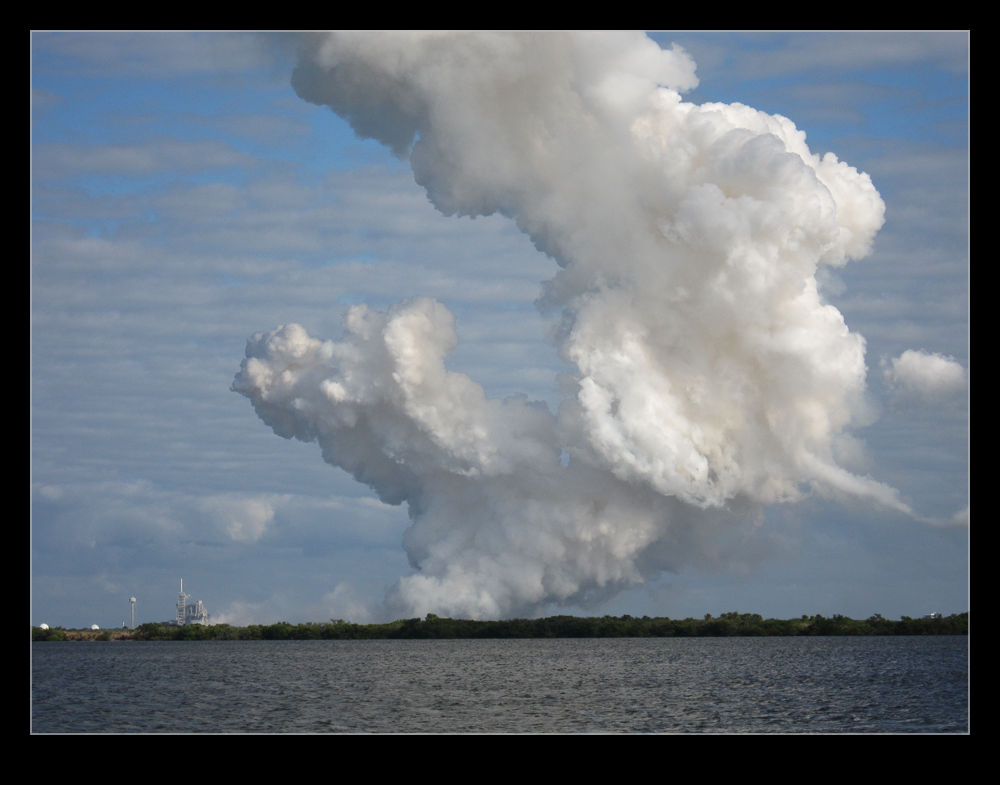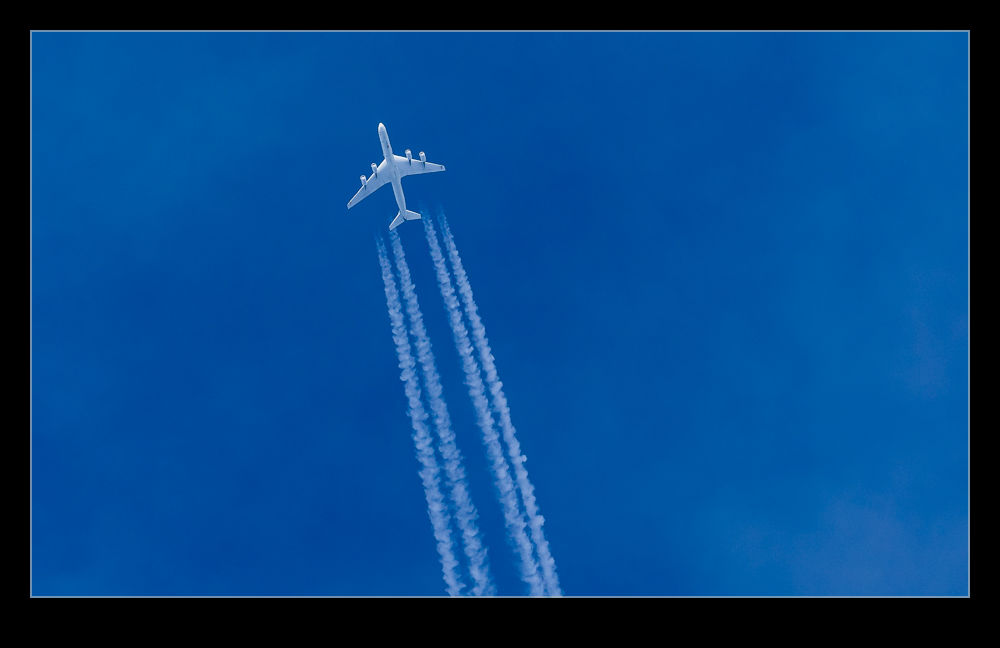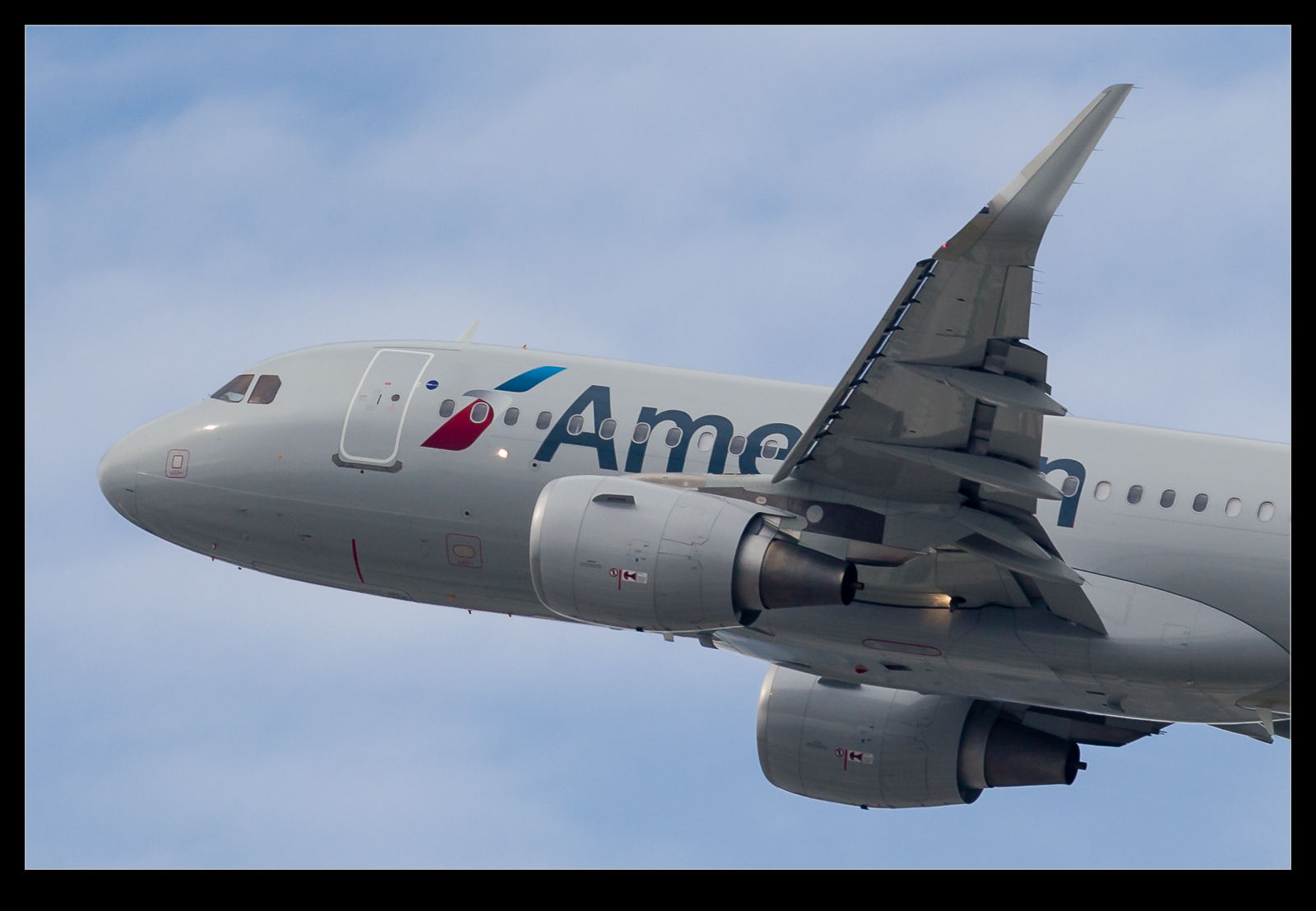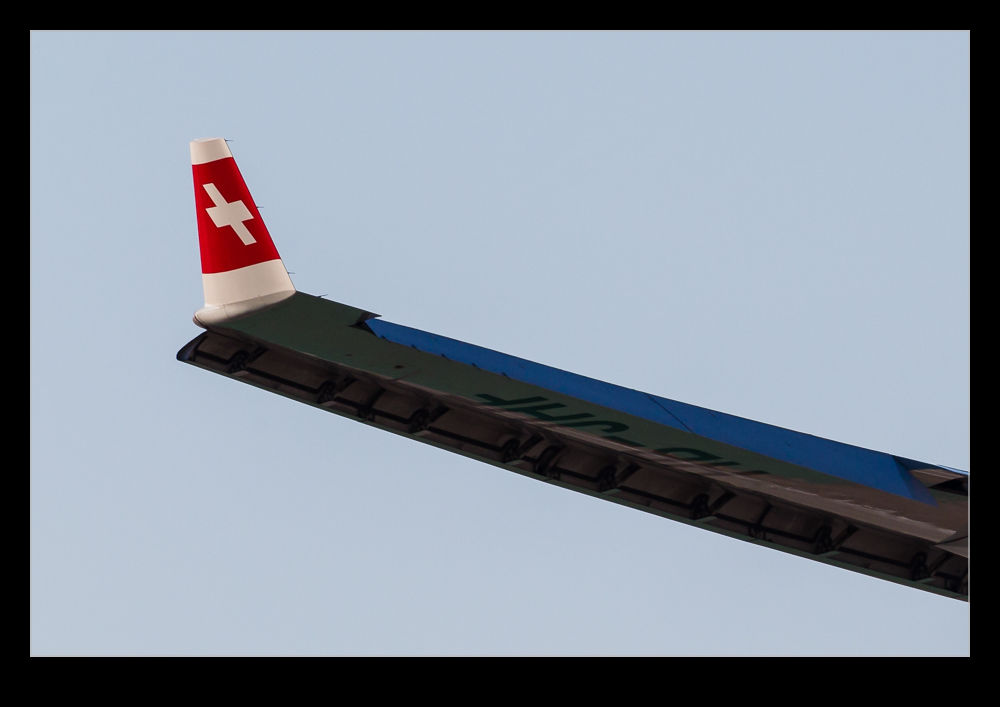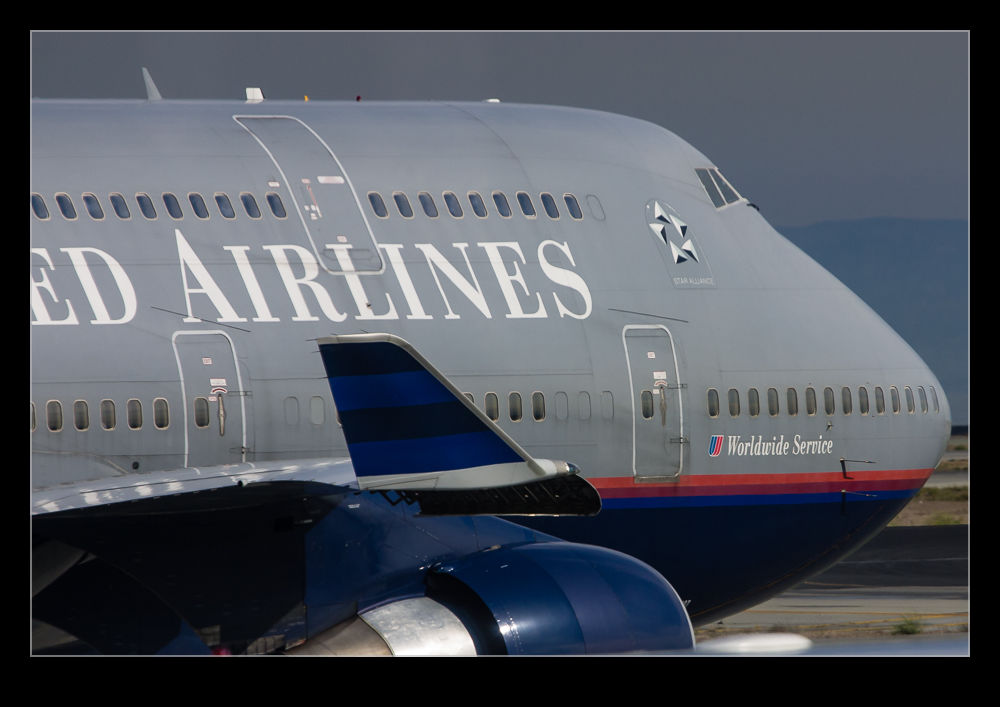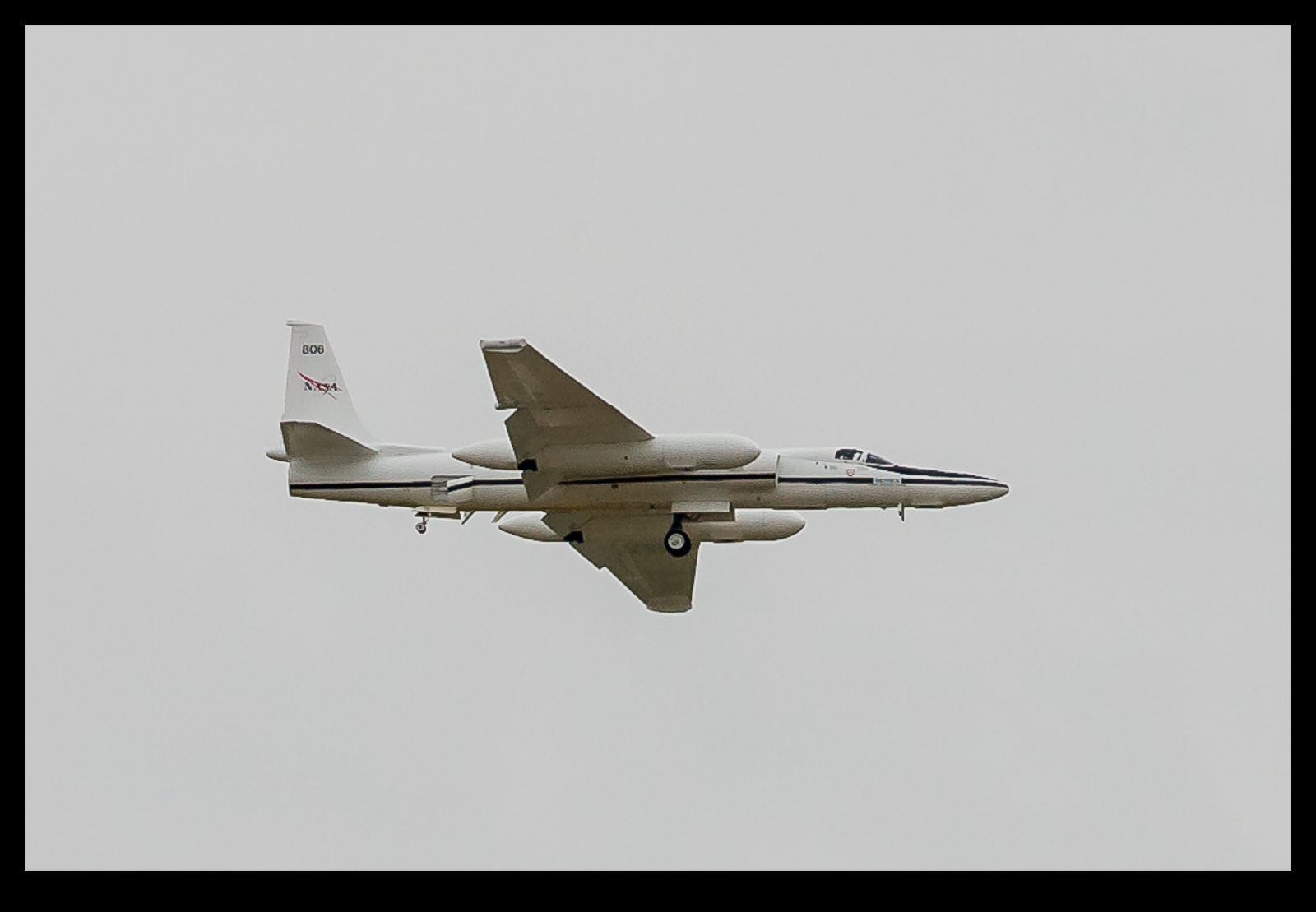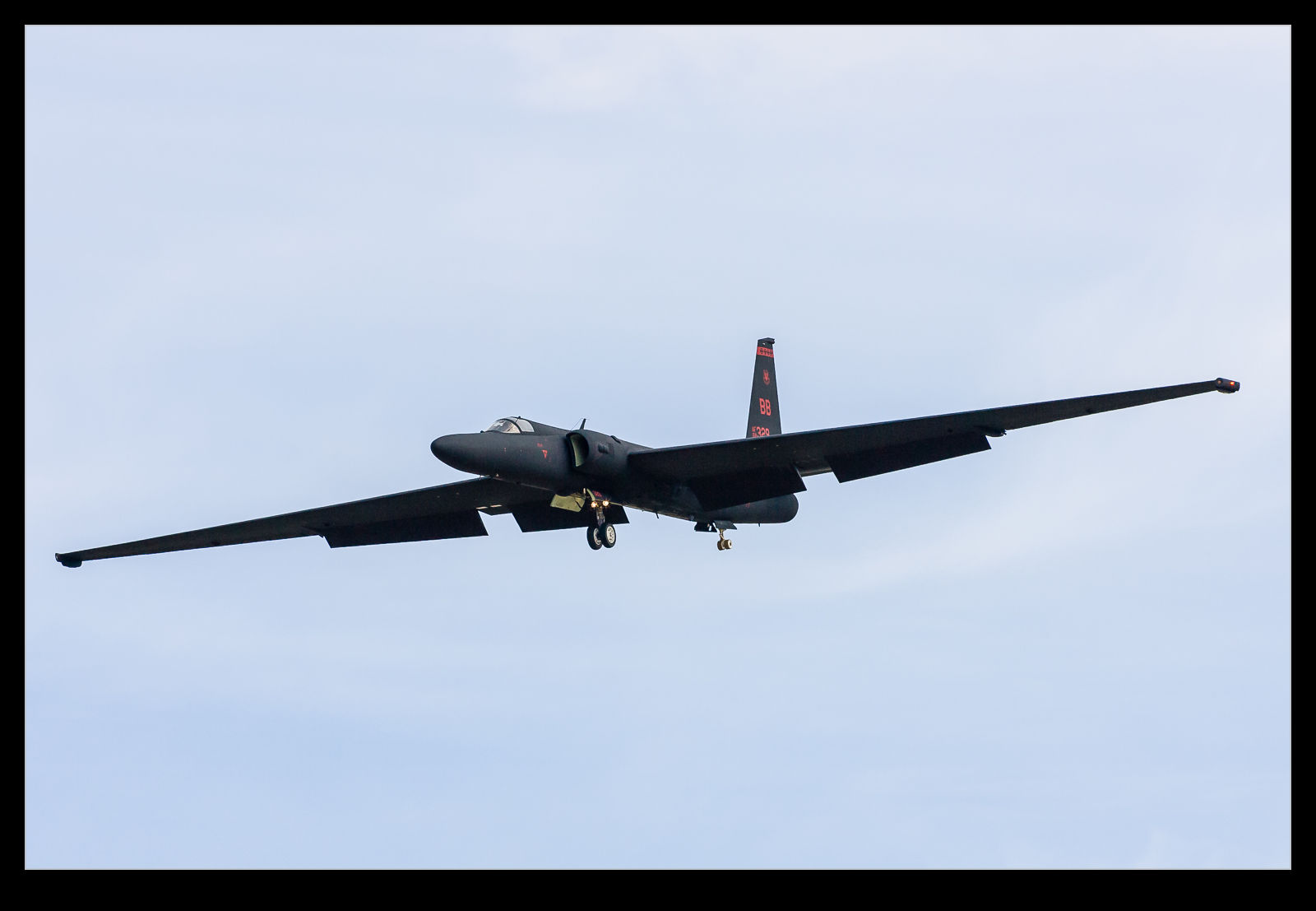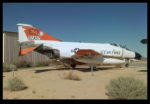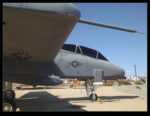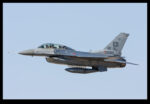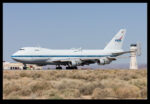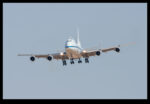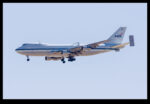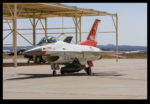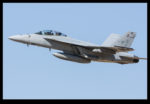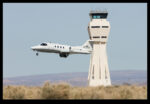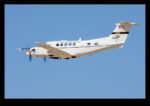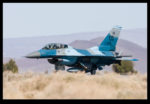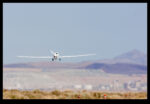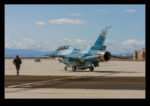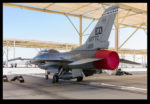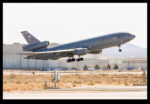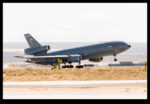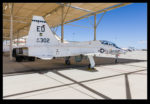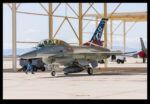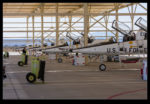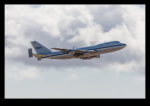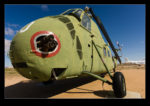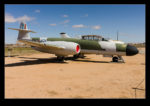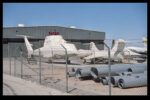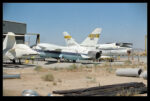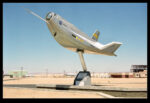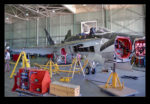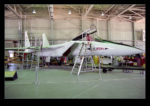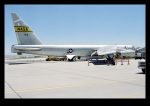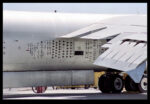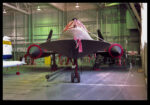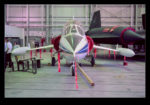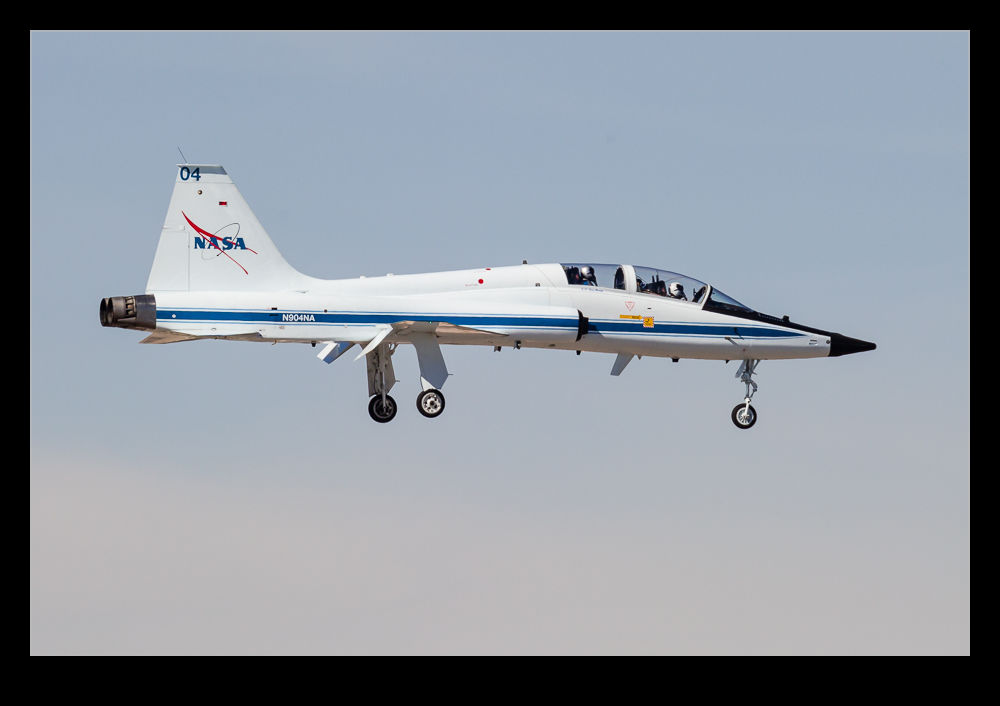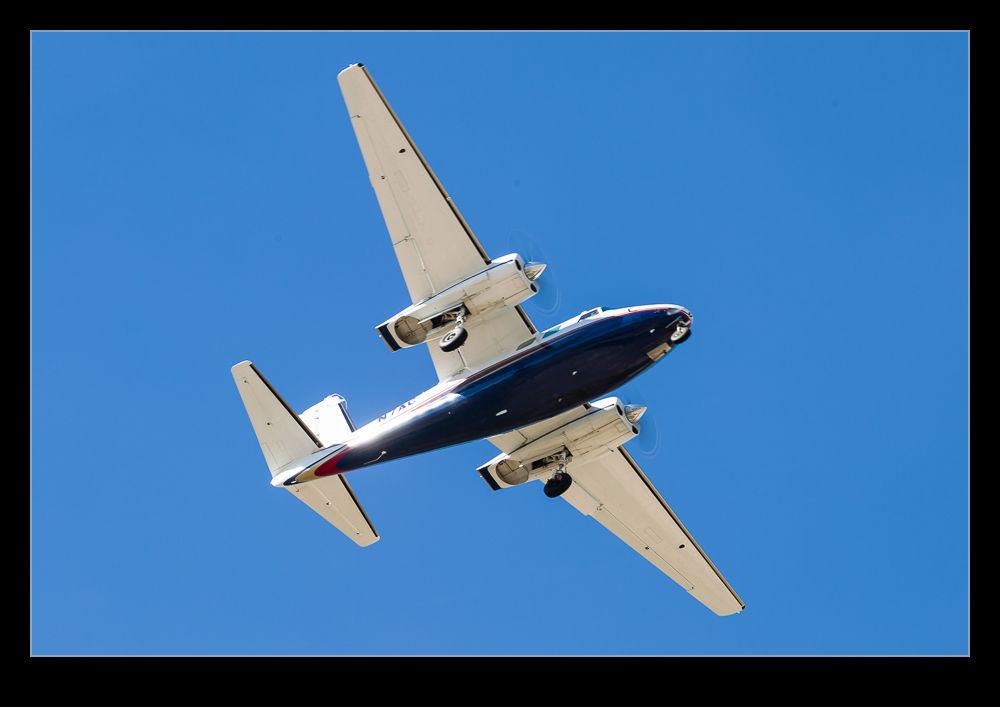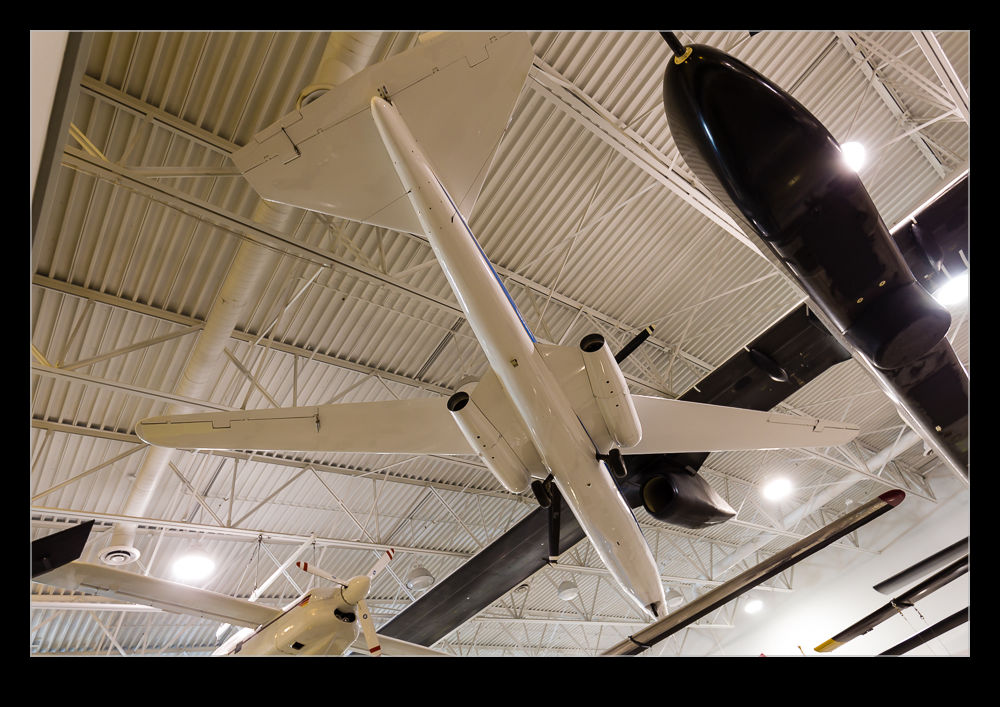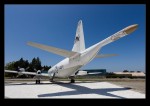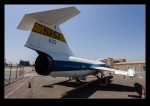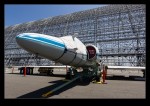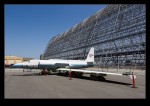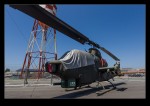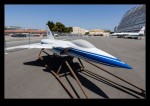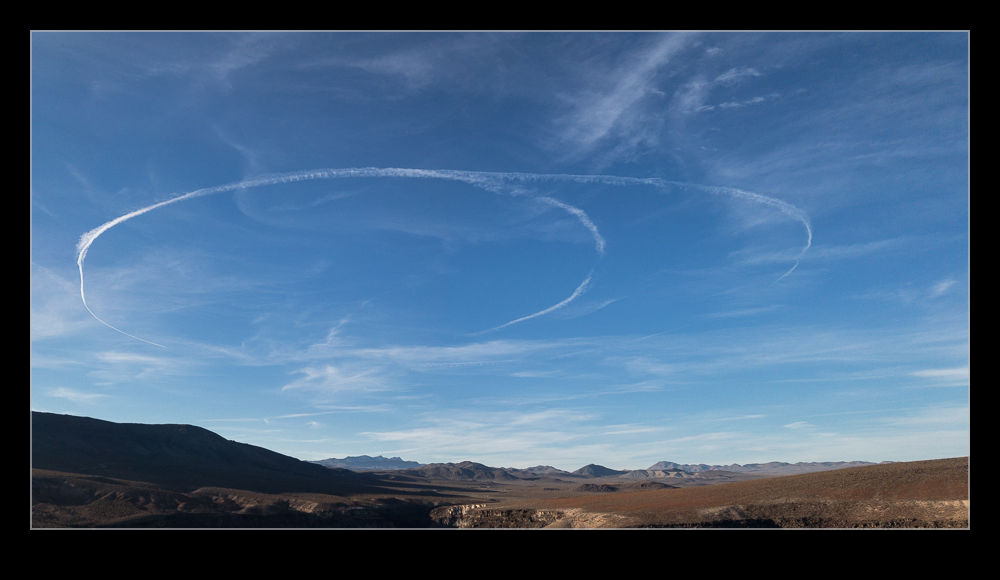 While hanging out at Rainbow Canyon awaiting the next jet, someone was flying high above. They were pulling a contrail at their altitude so you had a really good idea of their flightpath. They were flying regular extended orbits above us. The racetracks they left in the sky made it all pretty simple. A look at an ADS-B tracker told me that this wasn’t a tanker waiting for trade. It was NASA’s DC-8. This is a rare beast indeed and, while still a long way off, I was glad to get a shot of some sort of it.
While hanging out at Rainbow Canyon awaiting the next jet, someone was flying high above. They were pulling a contrail at their altitude so you had a really good idea of their flightpath. They were flying regular extended orbits above us. The racetracks they left in the sky made it all pretty simple. A look at an ADS-B tracker told me that this wasn’t a tanker waiting for trade. It was NASA’s DC-8. This is a rare beast indeed and, while still a long way off, I was glad to get a shot of some sort of it.
Tag Archives: NASA
Wingtip Treatments
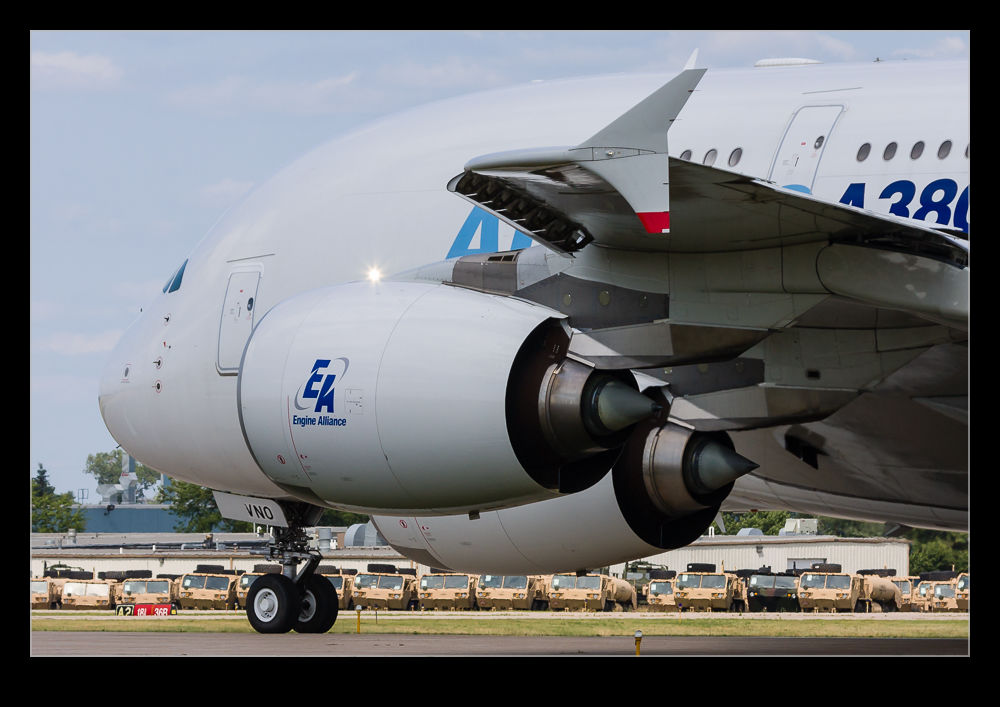 Richard Whitcomb was an aerodynamicist at NASA who pioneered a number of technologies that benefit the aviation world today. One of those was his development of winglets. These are the wingtip treatments that improve lift to drag ratio and climb performance without significantly extending the wing. While his work was clear, it took a while for them to be implemented widely. Now, most aircraft involve some sort of wingtip extension. However, the first aircraft to replicate his design approach was the MD-11.
Richard Whitcomb was an aerodynamicist at NASA who pioneered a number of technologies that benefit the aviation world today. One of those was his development of winglets. These are the wingtip treatments that improve lift to drag ratio and climb performance without significantly extending the wing. While his work was clear, it took a while for them to be implemented widely. Now, most aircraft involve some sort of wingtip extension. However, the first aircraft to replicate his design approach was the MD-11.
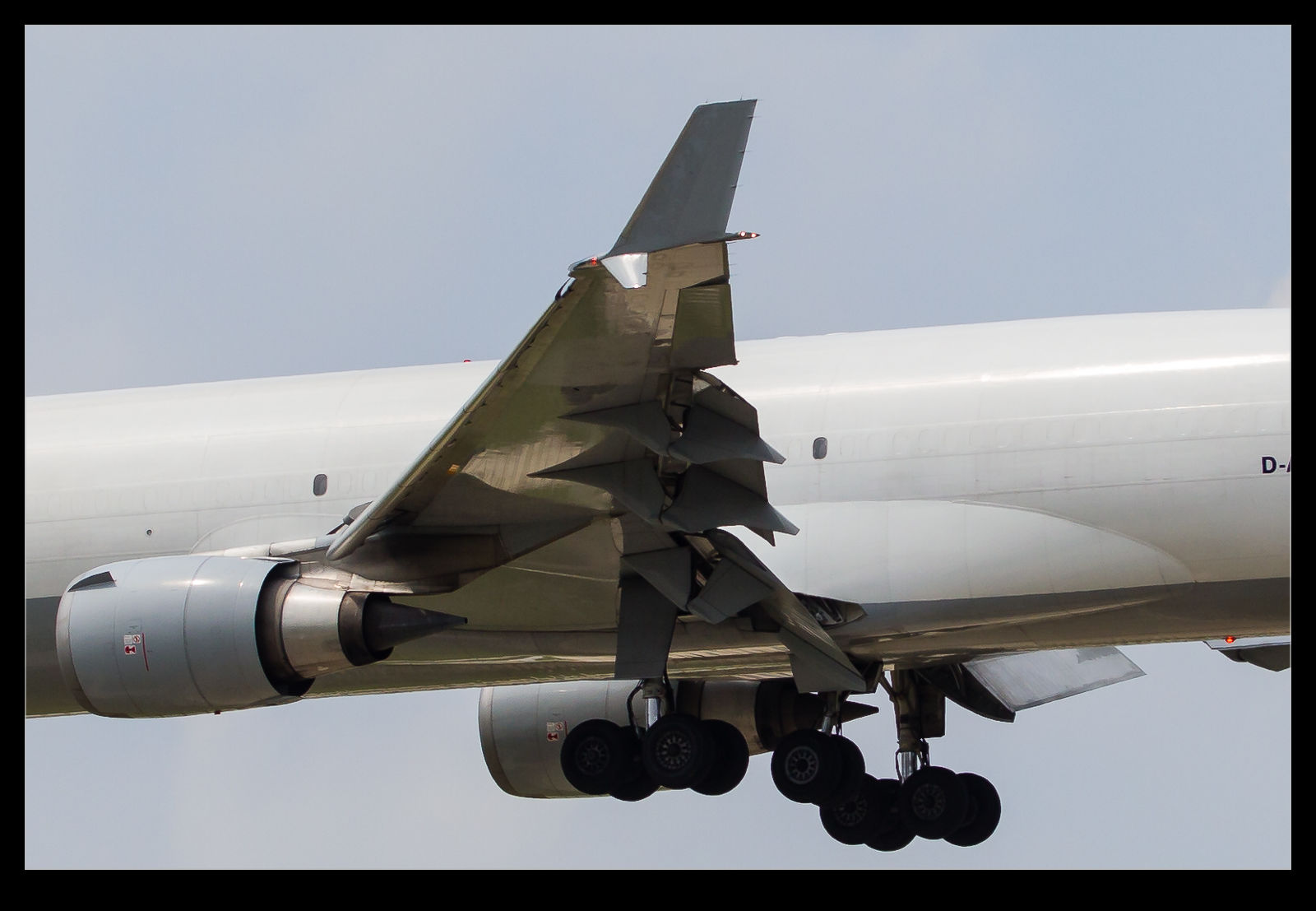 The MD-11 had a split winglet with a larger extension upwards and a smaller one downwards. This reflected some of Whitcomb’s original drawings. Strangely, after this, the focus was on upward winglets only (although the Airbus approach for a while was what they called a fence on the wingtip which was something more in keeping with the Whitcomb approach). Recently, there has been a return to the original with APB introducing the Split Scimitar and Boeing producing their own Split Winglet design (not as elegant as the APB approach in my mind.
The MD-11 had a split winglet with a larger extension upwards and a smaller one downwards. This reflected some of Whitcomb’s original drawings. Strangely, after this, the focus was on upward winglets only (although the Airbus approach for a while was what they called a fence on the wingtip which was something more in keeping with the Whitcomb approach). Recently, there has been a return to the original with APB introducing the Split Scimitar and Boeing producing their own Split Winglet design (not as elegant as the APB approach in my mind.
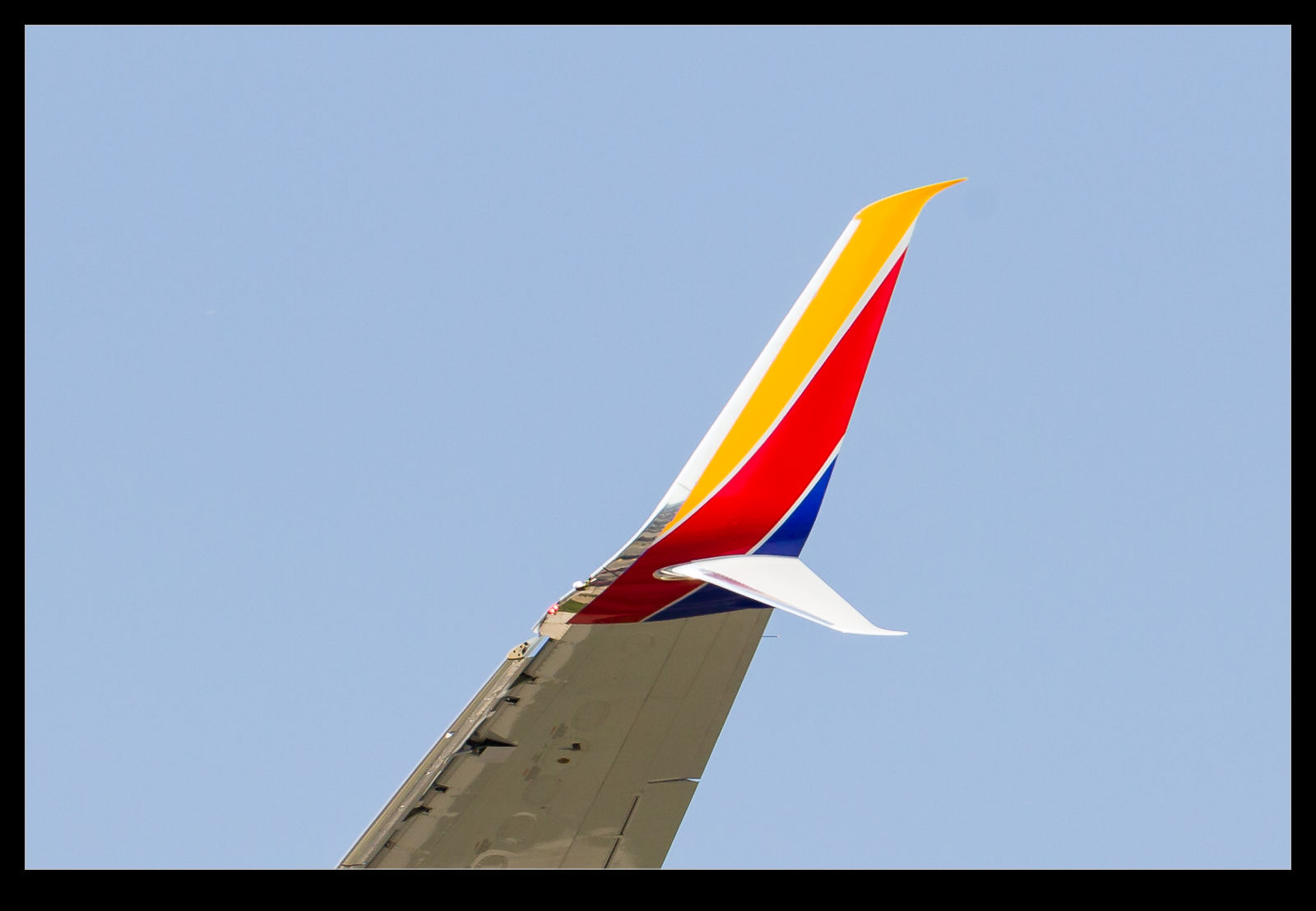 Most airliners and many business jets now incorporate a tweaked wing tip configuration. Maximizing the aerodynamic performance requires squeezing as much as you can out of the design within the space constraints you have. The following pictures are examples of the different types used.
Most airliners and many business jets now incorporate a tweaked wing tip configuration. Maximizing the aerodynamic performance requires squeezing as much as you can out of the design within the space constraints you have. The following pictures are examples of the different types used.
NASA Gulfstream STA
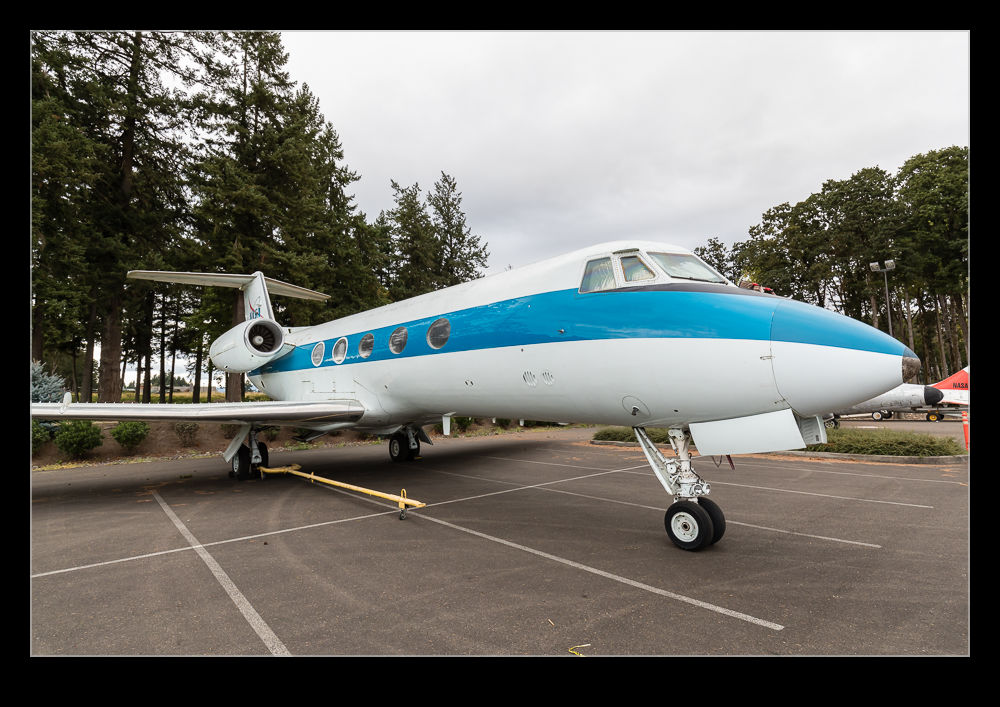 The Evergreen Aviation Museum has more aircraft than it has space to display. Some of them are parked out in the parking lot including a NASA Gulfstream II. This is no normal GII either. It is one of the four Gulfstreams that NASA had converted to act as Shuttle Training Aircraft (STA). They were used for the shuttle crews to practice the approach and landing phase of a mission when the shuttle was gliding (very steeply) in the atmosphere.
The Evergreen Aviation Museum has more aircraft than it has space to display. Some of them are parked out in the parking lot including a NASA Gulfstream II. This is no normal GII either. It is one of the four Gulfstreams that NASA had converted to act as Shuttle Training Aircraft (STA). They were used for the shuttle crews to practice the approach and landing phase of a mission when the shuttle was gliding (very steeply) in the atmosphere.
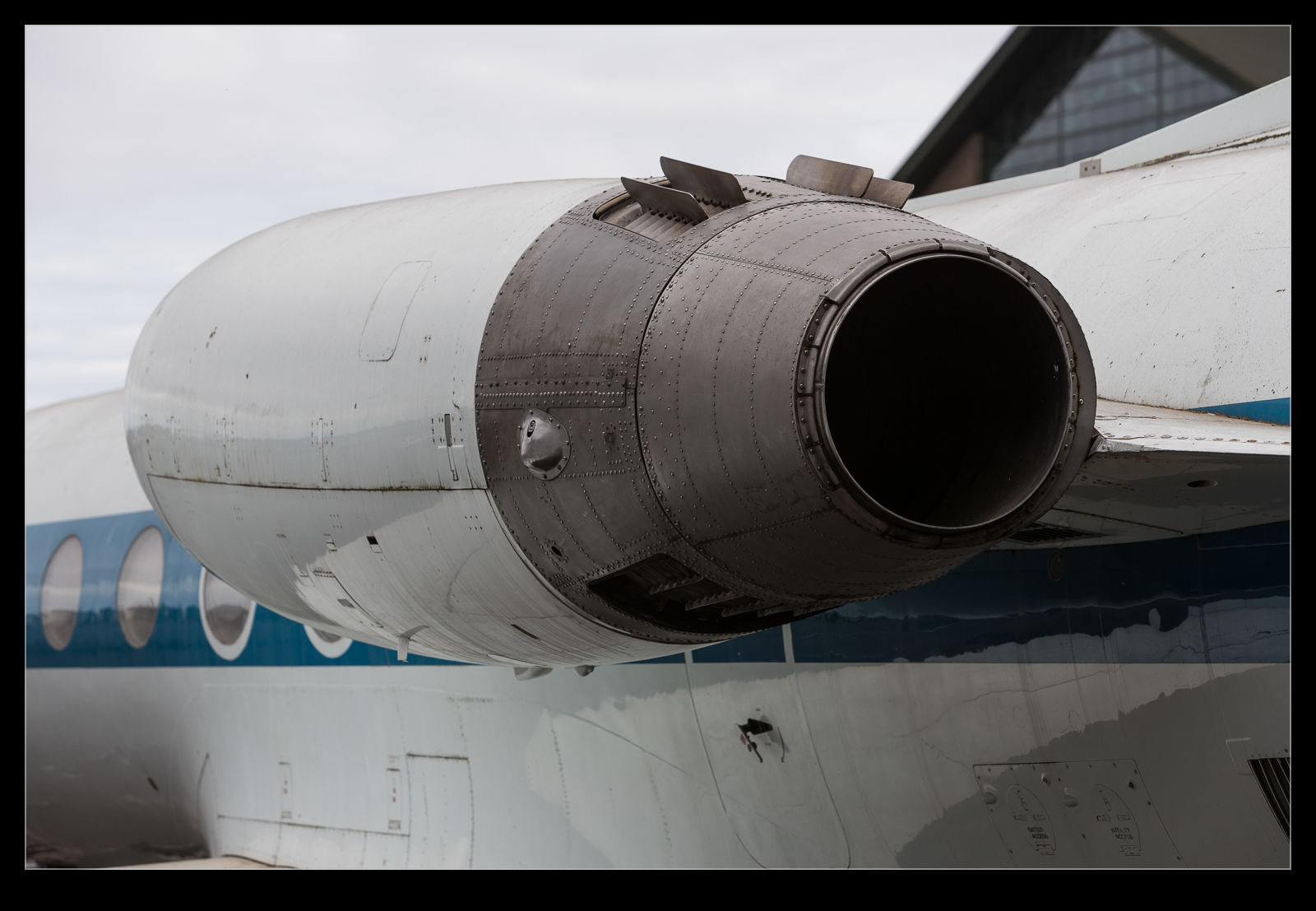 The main gear was deployed to increase drag, the thrust reversers were engaged in flight and the flaps could be moved up as well as down to modulate life. One seat was set up as a shuttle pilot station while an instructor sat in the other. Many practice landings could be carried out using the STA fleet. They also provided a secondary transport function.
The main gear was deployed to increase drag, the thrust reversers were engaged in flight and the flaps could be moved up as well as down to modulate life. One seat was set up as a shuttle pilot station while an instructor sat in the other. Many practice landings could be carried out using the STA fleet. They also provided a secondary transport function.
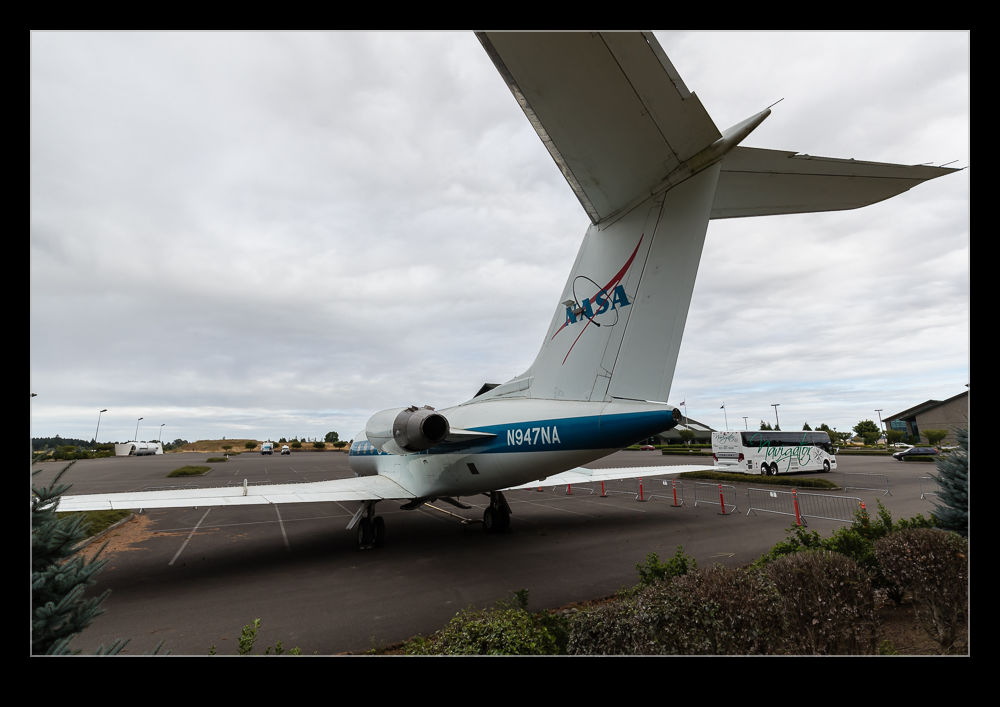 The aircraft is currently in a rather ignominious position in the parking lot and it will hopefully find a better permanent home.
The aircraft is currently in a rather ignominious position in the parking lot and it will hopefully find a better permanent home.
Palmdale Day Out
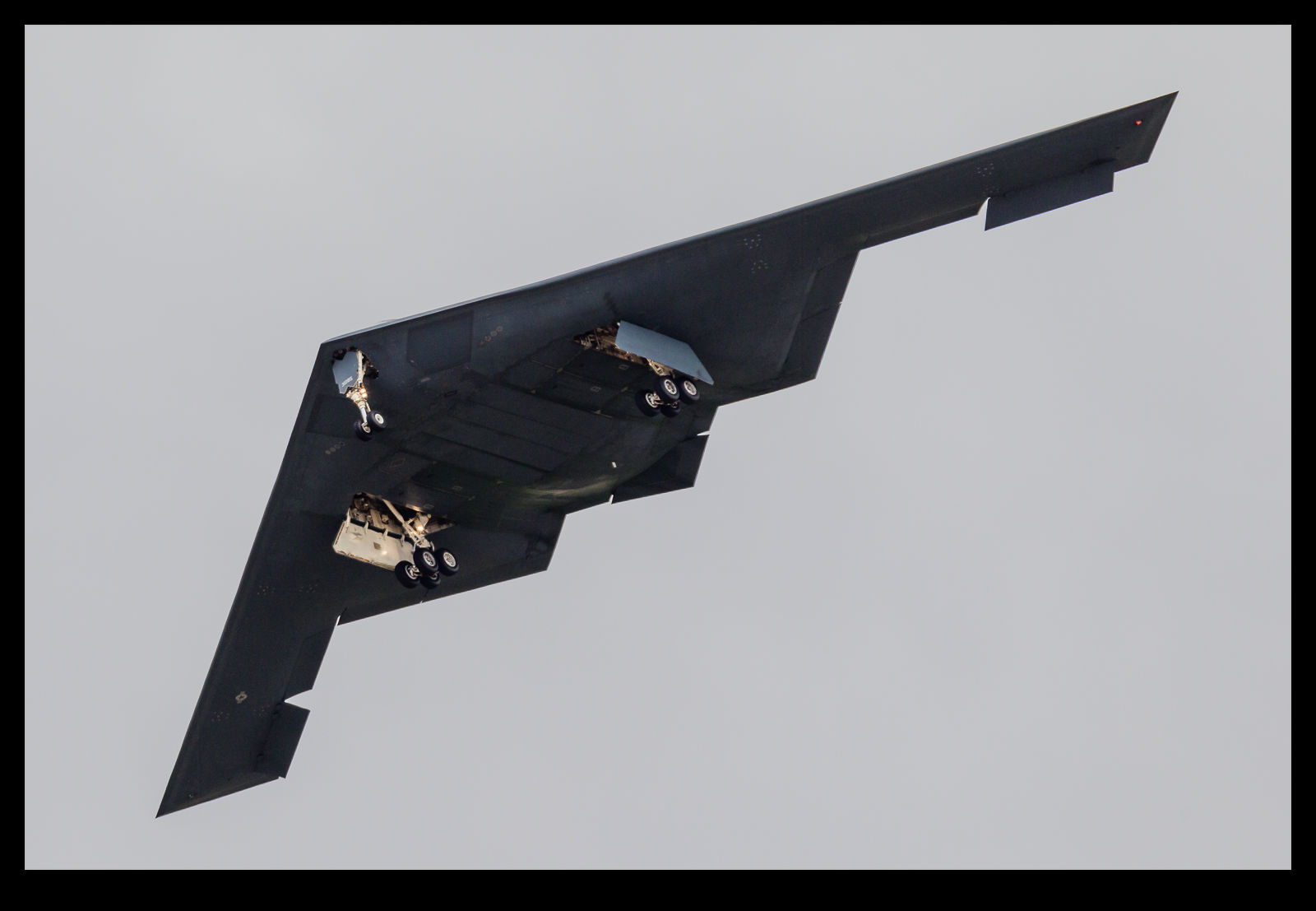 A few years ago, I was in the LA area with my mate Paul. We decided to try our luck with a visit to Palmdale. Home of Air Force Plant 42, Palmdale has a history of interesting aircraft. The Blackbirds were assembled here as were the Space Shuttles. The B-2 bombers were also assembled on site. It is home to some NASA aircraft and continues to support a variety of types. Consequently, you can see some really interesting stuff. Alternatively, you can have a day with nothing going on. It is the luck of the draw.
A few years ago, I was in the LA area with my mate Paul. We decided to try our luck with a visit to Palmdale. Home of Air Force Plant 42, Palmdale has a history of interesting aircraft. The Blackbirds were assembled here as were the Space Shuttles. The B-2 bombers were also assembled on site. It is home to some NASA aircraft and continues to support a variety of types. Consequently, you can see some really interesting stuff. Alternatively, you can have a day with nothing going on. It is the luck of the draw.
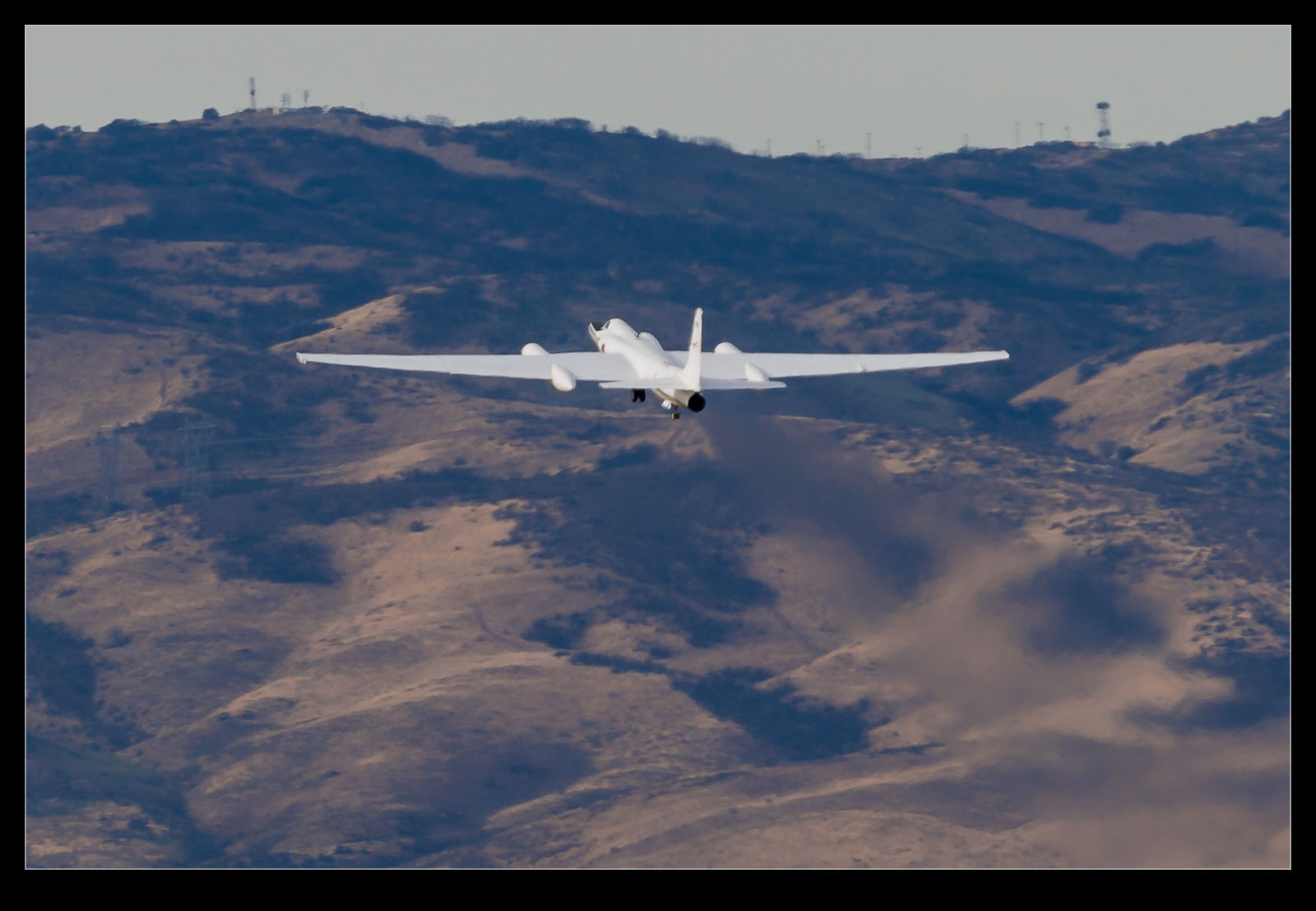 We decided to try it out anyway and see what we could get. One of the NASA ER-2s had been active so there was hope that it might be up and about. One thing we hadn’t anticipated was that the weather was not going to be great. We had figured it was likely to be clear but actually there was a fair amount of cloud cover all day. Not ideal but it did keep the temperature down.
We decided to try it out anyway and see what we could get. One of the NASA ER-2s had been active so there was hope that it might be up and about. One thing we hadn’t anticipated was that the weather was not going to be great. We had figured it was likely to be clear but actually there was a fair amount of cloud cover all day. Not ideal but it did keep the temperature down.
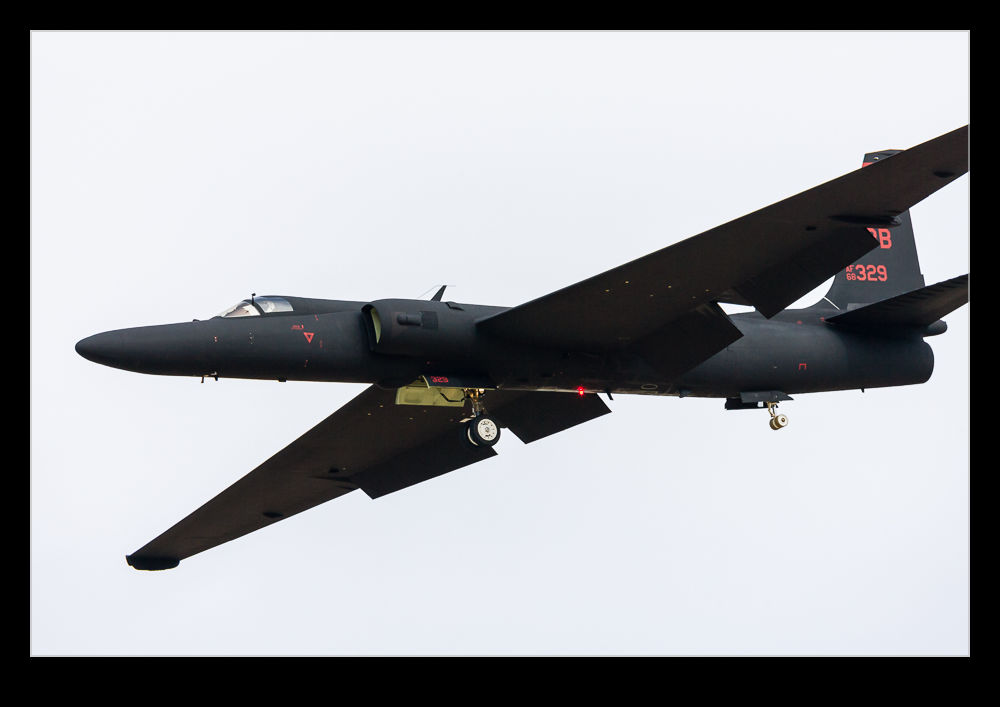 We did have success with the ER-2. Unfortunately, we did not choose well for our locations. It took off and landed on the runway that we were not close too. Consequently, we got some shots but they were a bit distant. We discussed a rapid change of location but, fearing we would get nothing by being in the car at the wrong time, stuck with it.
We did have success with the ER-2. Unfortunately, we did not choose well for our locations. It took off and landed on the runway that we were not close too. Consequently, we got some shots but they were a bit distant. We discussed a rapid change of location but, fearing we would get nothing by being in the car at the wrong time, stuck with it.
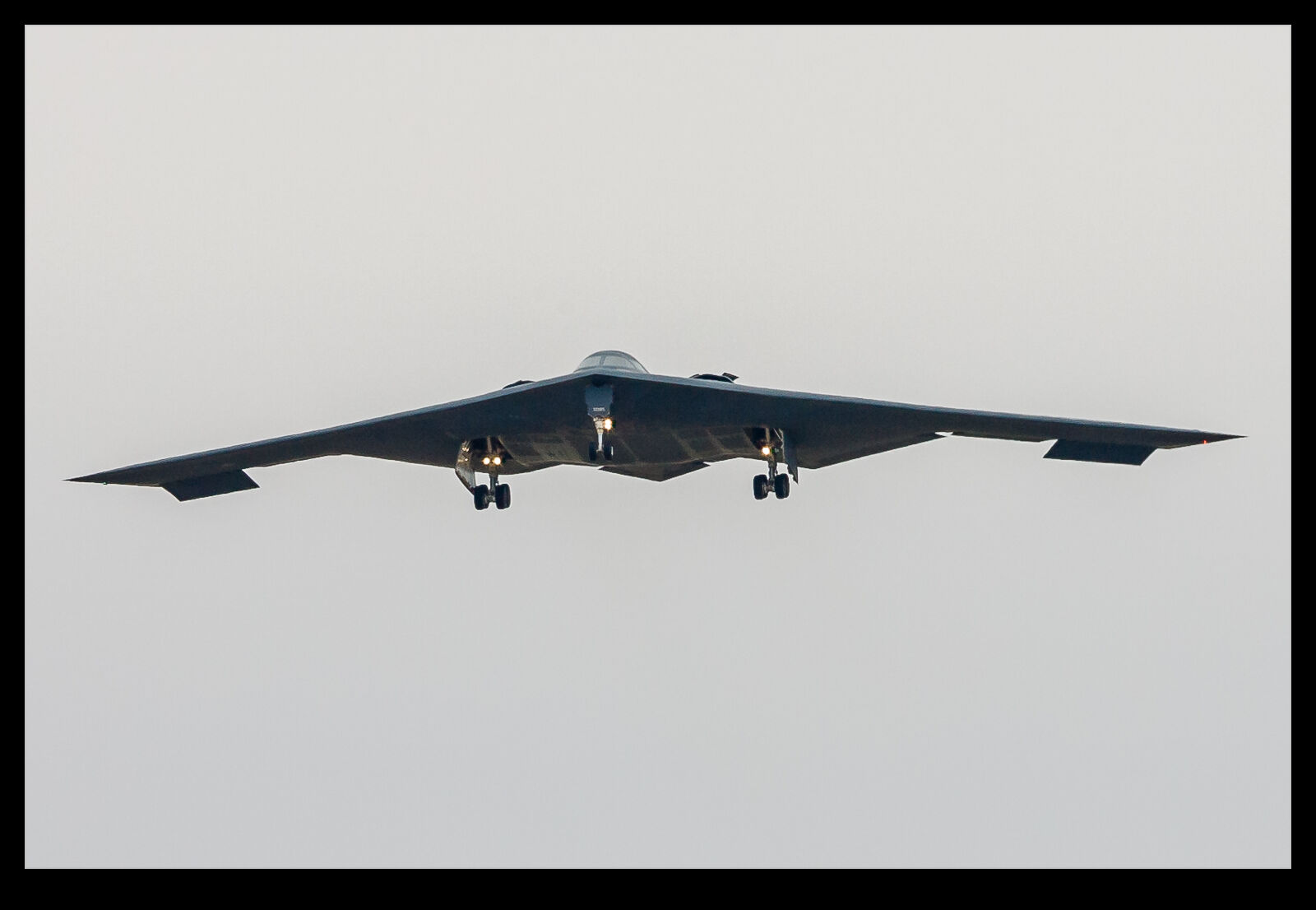 Our location was not a total bust though. We did get a sister ship. A USAF U-2S came in and we got some shots of that. It was not alone. A B-2 also made some approaches. We figured it was coming from Edwards and heading back there again. Sadly, shooting black aircraft against a cloudy sky is a bit tricky. Still, we might have done worse. After a while, the local movements of Northrop Grumman shuttles had been enough so we decided to get on the road back to LA.
Our location was not a total bust though. We did get a sister ship. A USAF U-2S came in and we got some shots of that. It was not alone. A B-2 also made some approaches. We figured it was coming from Edwards and heading back there again. Sadly, shooting black aircraft against a cloudy sky is a bit tricky. Still, we might have done worse. After a while, the local movements of Northrop Grumman shuttles had been enough so we decided to get on the road back to LA.
Edwards AFB 2010
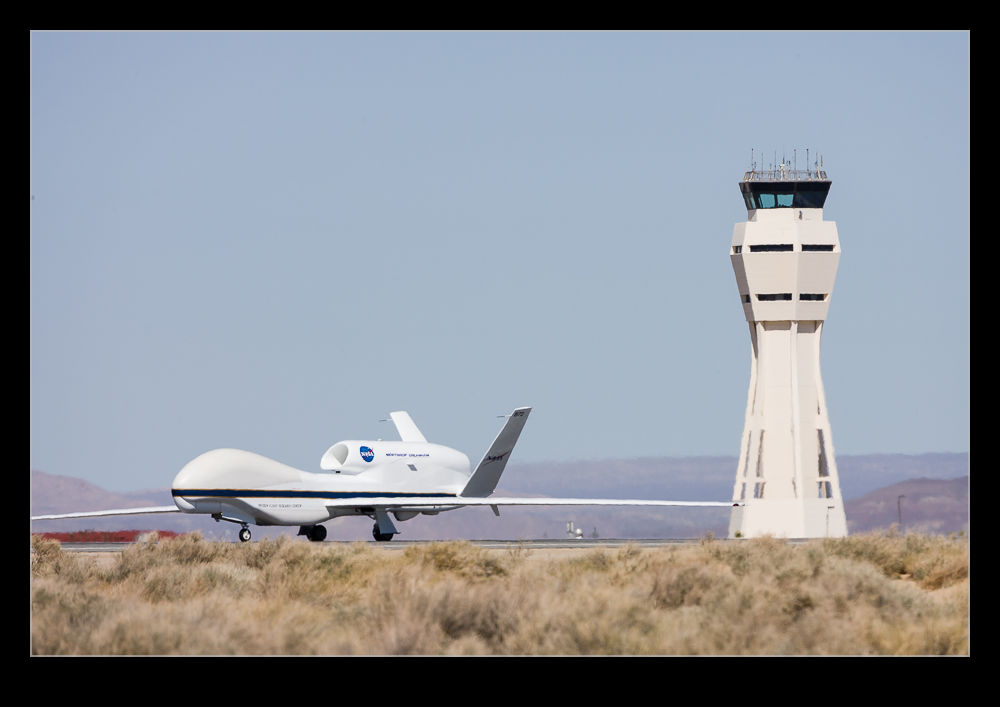 My first trip to Edwards AFB was in 1990 as I wrote about in this blog post. My next trip was quite a bit later. This was a visit arranged by my friend Richard ahead of an ISAP symposium. It also allowed a lot more opportunity to see the aircraft. The visit was broken in to two main elements. The first was a walk along the flightline and the second was heading to the other side of the runway to shoot arrivals and departures.
My first trip to Edwards AFB was in 1990 as I wrote about in this blog post. My next trip was quite a bit later. This was a visit arranged by my friend Richard ahead of an ISAP symposium. It also allowed a lot more opportunity to see the aircraft. The visit was broken in to two main elements. The first was a walk along the flightline and the second was heading to the other side of the runway to shoot arrivals and departures.
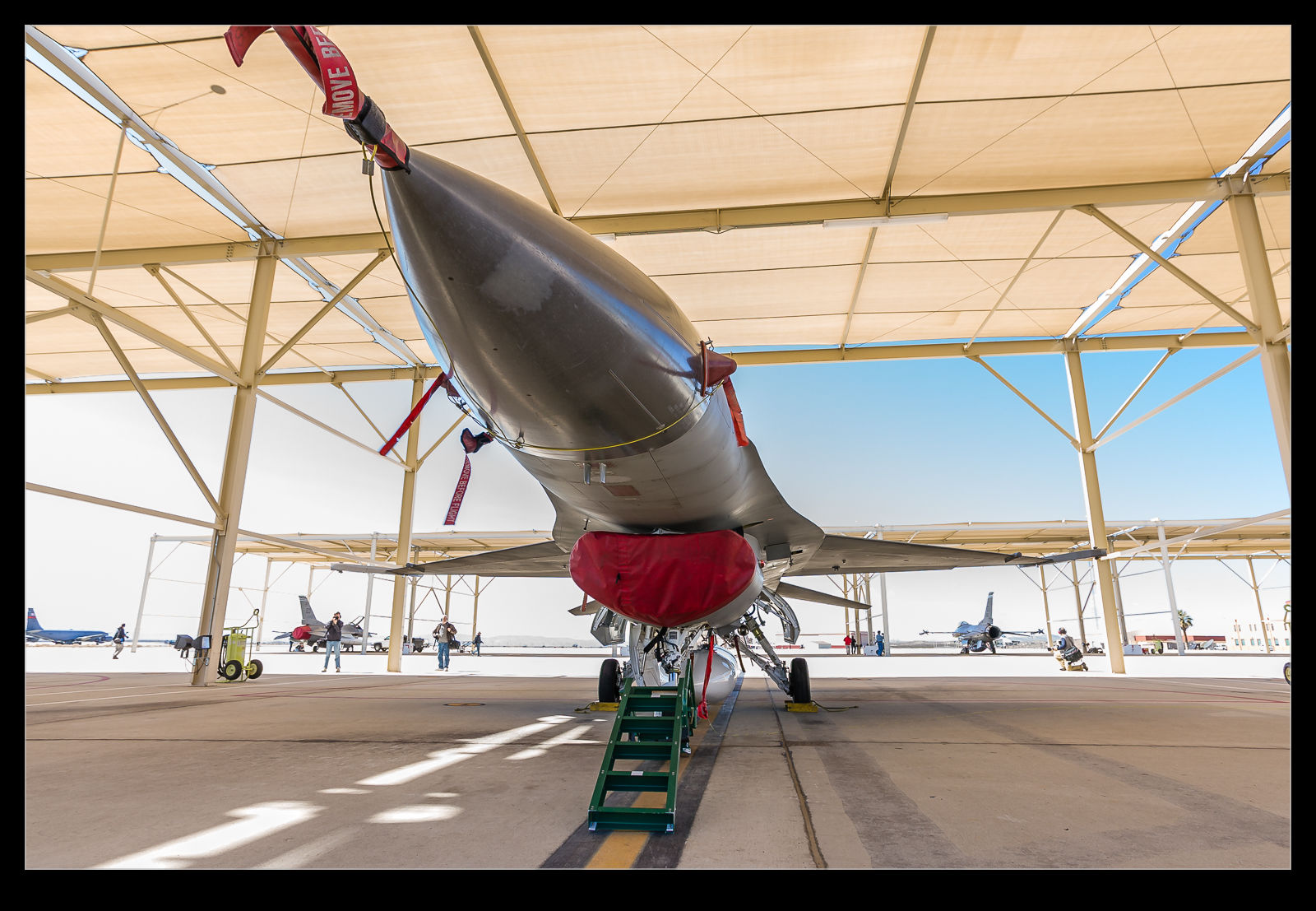 The diversity of types on the flightline has dwindled since 1990. Now there are an awful lot of F-16s and not so many other types. However, test jets look cool in their non-operational colors. Shooting under the sun shades is good for protection from the elements but it does make for some wide ranges of lighting conditions and some odd color casts.
The diversity of types on the flightline has dwindled since 1990. Now there are an awful lot of F-16s and not so many other types. However, test jets look cool in their non-operational colors. Shooting under the sun shades is good for protection from the elements but it does make for some wide ranges of lighting conditions and some odd color casts.
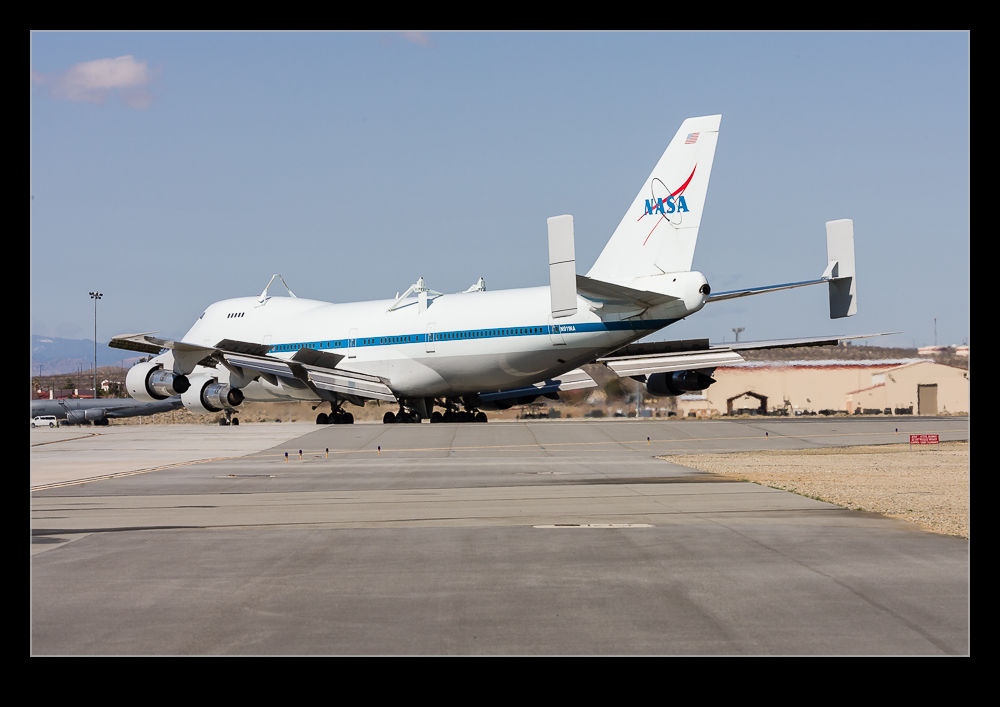 Once on the other side of the runway, we had some great options for shooting the jets in action. Heat haze is always a problem, particularly somewhere as warm as Edwards can be, but you can still get some interesting aircraft. We were hoping to see some F-35s but were disappointed this time. However, we did get one of the F-35 test support F-16s from Denmark which was nice to see. We also had aircraft from the Test Pilot School out doing their thing.
Once on the other side of the runway, we had some great options for shooting the jets in action. Heat haze is always a problem, particularly somewhere as warm as Edwards can be, but you can still get some interesting aircraft. We were hoping to see some F-35s but were disappointed this time. However, we did get one of the F-35 test support F-16s from Denmark which was nice to see. We also had aircraft from the Test Pilot School out doing their thing.
 A couple of more unusual aircraft showed up while we were there. One off the NASA Shuttle Carrier Aircraft was on a training sortie. With the program now curtailed, this was the last chance I had to see one of these 747s in the air although not with a shuttle mounted on it! NASA was also using one of their Global Hawks UAVs and it landed while we were there. An old Gulfstream also landed. It had unusual markings to simulate a missile for tracking systems. This used to be undertaken by a C-135 aircraft but it has been retired and replaced by the Gulfstream which, while not a new jet, is still probably a lot cheaper to operate.
A couple of more unusual aircraft showed up while we were there. One off the NASA Shuttle Carrier Aircraft was on a training sortie. With the program now curtailed, this was the last chance I had to see one of these 747s in the air although not with a shuttle mounted on it! NASA was also using one of their Global Hawks UAVs and it landed while we were there. An old Gulfstream also landed. It had unusual markings to simulate a missile for tracking systems. This used to be undertaken by a C-135 aircraft but it has been retired and replaced by the Gulfstream which, while not a new jet, is still probably a lot cheaper to operate.
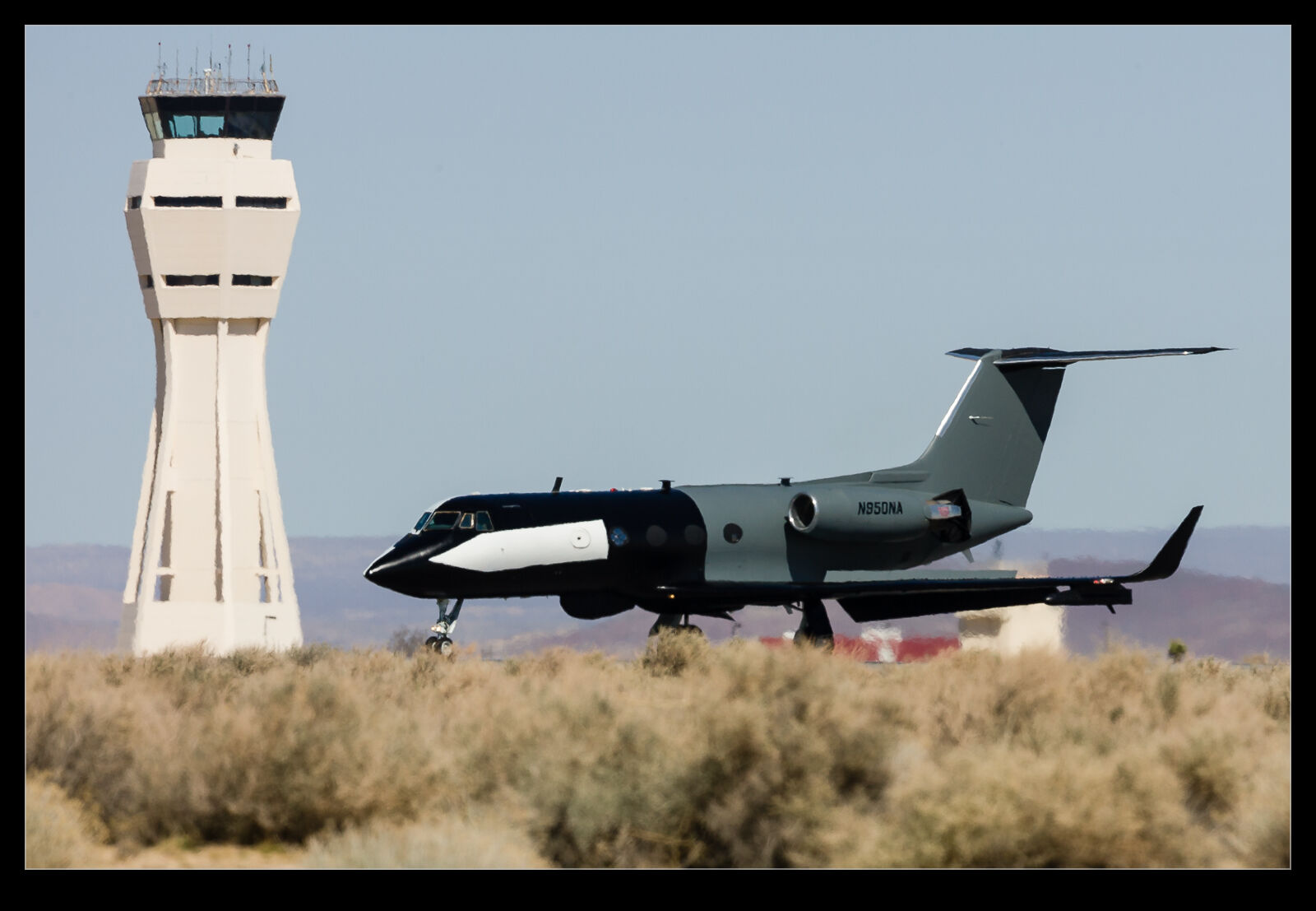 We also got to see some of the museum aircraft including the twin seat A-10 I had shot in 1990! The trip was over far too soon but we had a great time and saw some cool stuff. Thanks to Richard for organizing. Now I need to get myself back there to see what the latest fleet is up to.
We also got to see some of the museum aircraft including the twin seat A-10 I had shot in 1990! The trip was over far too soon but we had a great time and saw some cool stuff. Thanks to Richard for organizing. Now I need to get myself back there to see what the latest fleet is up to.
Edwards AFB 1990
 My first visit to the United States was in 1990. I had just graduated from university and was joining my Dad on a trip he was making at the time. I was to meet up with him in Los Angeles and travel around California before ending up in San Francisco for a week. Since I had a date to meet him but no previous constraints, I made the flight out a couple of days early so I could go and explore. Where did I want to go? How could I not come this far and not visit Edwards AFB.
My first visit to the United States was in 1990. I had just graduated from university and was joining my Dad on a trip he was making at the time. I was to meet up with him in Los Angeles and travel around California before ending up in San Francisco for a week. Since I had a date to meet him but no previous constraints, I made the flight out a couple of days early so I could go and explore. Where did I want to go? How could I not come this far and not visit Edwards AFB.
 A famous flight test center, seen of many records, home of some unusual aircraft, Edwards was a place I really wanted to see. In those days, there were two tours available. The Air Force had a tour in the morning and NASA had a tour in the afternoon. Make an early start and you could cover both with ease.
A famous flight test center, seen of many records, home of some unusual aircraft, Edwards was a place I really wanted to see. In those days, there were two tours available. The Air Force had a tour in the morning and NASA had a tour in the afternoon. Make an early start and you could cover both with ease.
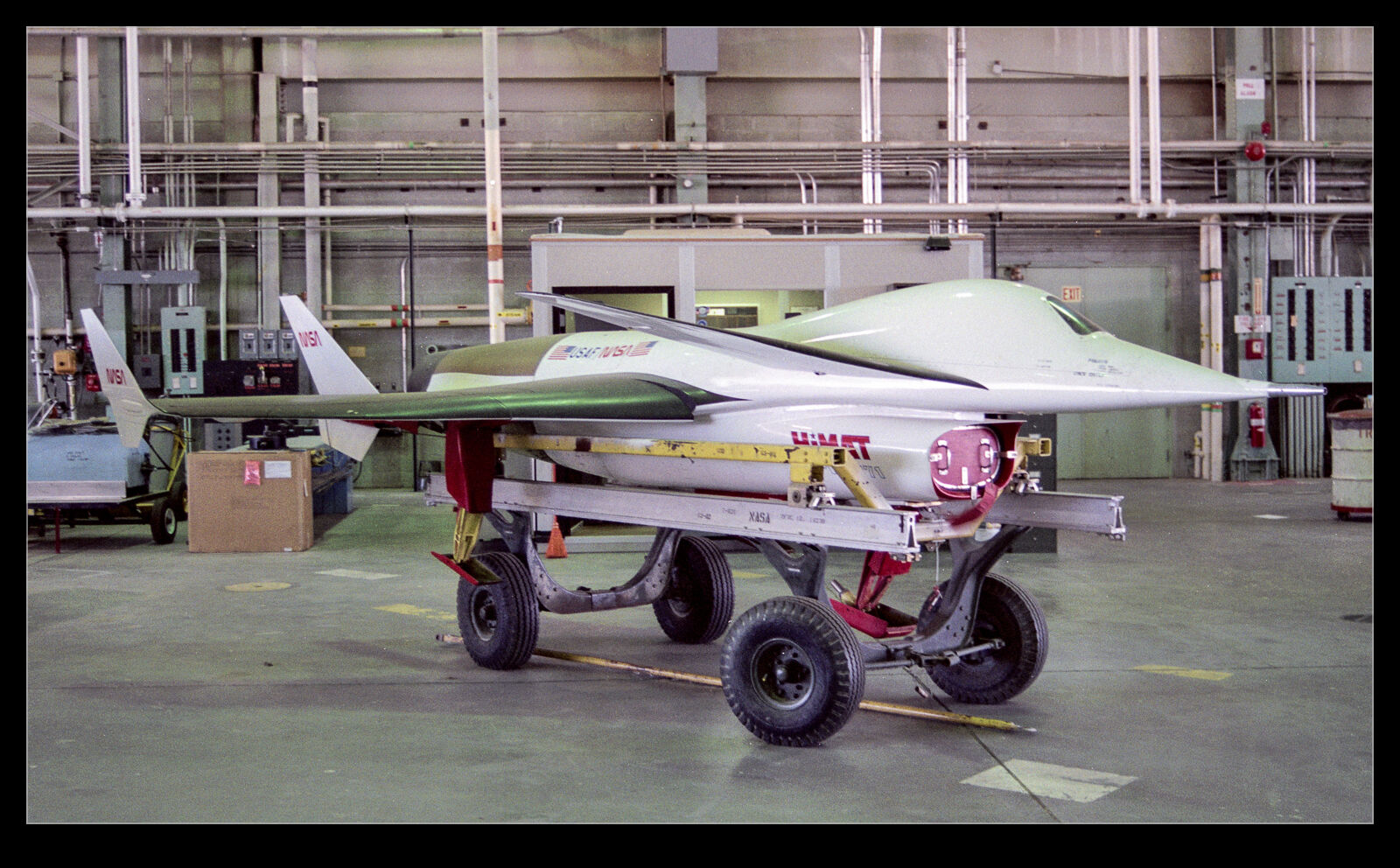 The Air Force tour included a bus ride along the side of the flightline. You didn’t get to step outside near the active jets but they did take us out onto the lakebed and to see a few of the stored aircraft that would be part of the museum in years to come. The flightline was full of F-16s and F-4s with F-111s and other jets scattered amongst them. So much that is now gone was on show. This was also just after the YF-23 had been rolled out. We were told we couldn’t take any pictures of it if we happened to see it but sadly it was tucked away while we were there. It would be a long time before I finally saw one for real.
The Air Force tour included a bus ride along the side of the flightline. You didn’t get to step outside near the active jets but they did take us out onto the lakebed and to see a few of the stored aircraft that would be part of the museum in years to come. The flightline was full of F-16s and F-4s with F-111s and other jets scattered amongst them. So much that is now gone was on show. This was also just after the YF-23 had been rolled out. We were told we couldn’t take any pictures of it if we happened to see it but sadly it was tucked away while we were there. It would be a long time before I finally saw one for real.
 After lunch it was over to the NASA part of the base. This was paradise for someone like me. So many test aircraft either in maintenance or storage. There was an SR-71 in one hangar, plenty of F/A-18 Hornets (including the HARV demonstrator and another airframe that appeared to have been used for mocking up the engine paddles), F-104s, an F-15, the HiMAT and, out in the storage lot, the supercritical F-8 and the Sikorsky RSRA all stuck in a fenced off area. I missed some other things I would liked to have seen including the X-29, X-31 and the STOL/MTD F-15 but it was still an impressive lineup.
After lunch it was over to the NASA part of the base. This was paradise for someone like me. So many test aircraft either in maintenance or storage. There was an SR-71 in one hangar, plenty of F/A-18 Hornets (including the HARV demonstrator and another airframe that appeared to have been used for mocking up the engine paddles), F-104s, an F-15, the HiMAT and, out in the storage lot, the supercritical F-8 and the Sikorsky RSRA all stuck in a fenced off area. I missed some other things I would liked to have seen including the X-29, X-31 and the STOL/MTD F-15 but it was still an impressive lineup.
 The end of the 80s was a great time with so many programs funded. It might not have been as diverse as the 50s and 60s but it was still great to go there when so much was to be seen. These days, visits require a lot more planning and the number of types in use has dwindled. However, it is still worth a trip and another post shall cover that.
The end of the 80s was a great time with so many programs funded. It might not have been as diverse as the 50s and 60s but it was still great to go there when so much was to be seen. These days, visits require a lot more planning and the number of types in use has dwindled. However, it is still worth a trip and another post shall cover that.
NASA T-38
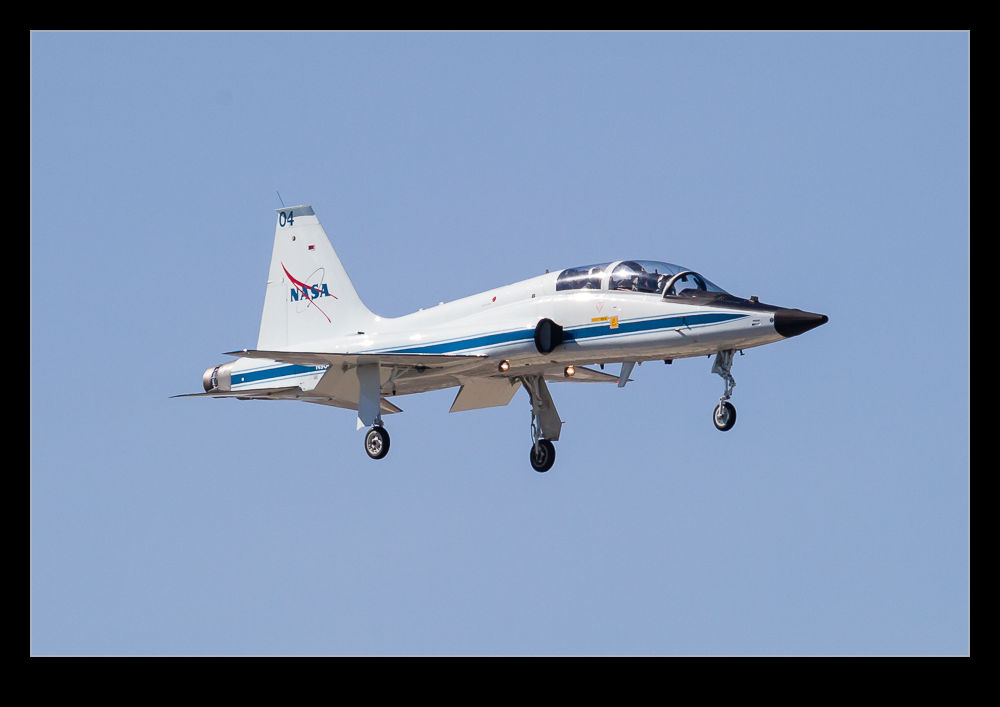 As the visit to McCarran was getting towards the time we needed to leave for the Red Flag launch, we checked Flightaware and saw that a NASA T-38 was inbound. This was worthy of some attention. The question was, which runway would it land on? We hopped in the car and headed off to a spot near the 25 threshold. This was the direction it was coming from. If it made a straight in approach, we would catch it here. If it was directed to the 01 approach, it would need time to reposition and we would be able to move to a more suitable location.
As the visit to McCarran was getting towards the time we needed to leave for the Red Flag launch, we checked Flightaware and saw that a NASA T-38 was inbound. This was worthy of some attention. The question was, which runway would it land on? We hopped in the car and headed off to a spot near the 25 threshold. This was the direction it was coming from. If it made a straight in approach, we would catch it here. If it was directed to the 01 approach, it would need time to reposition and we would be able to move to a more suitable location.
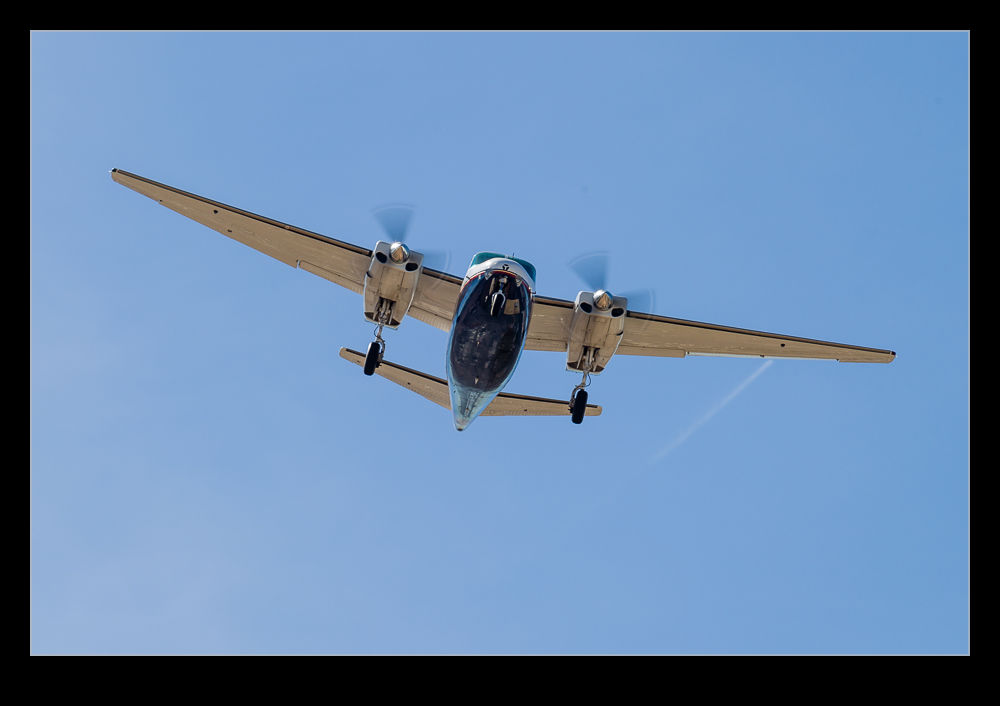 We tracked the plane online and a look at the line of airliners up the approach told us it was going to 01. A hasty change of locations followed and we got to a suitable spot. An Aero Commander landed first which gave us an idea of the approach path. Then, the T-38 came into view. As is the case with the Talon, it was motoring down the approach. A quick adjustment and a few shots and then it was gone. All rather brief but a nice way to wrap up the visit.
We tracked the plane online and a look at the line of airliners up the approach told us it was going to 01. A hasty change of locations followed and we got to a suitable spot. An Aero Commander landed first which gave us an idea of the approach path. Then, the T-38 came into view. As is the case with the Talon, it was motoring down the approach. A quick adjustment and a few shots and then it was gone. All rather brief but a nice way to wrap up the visit.
Oblique Wing
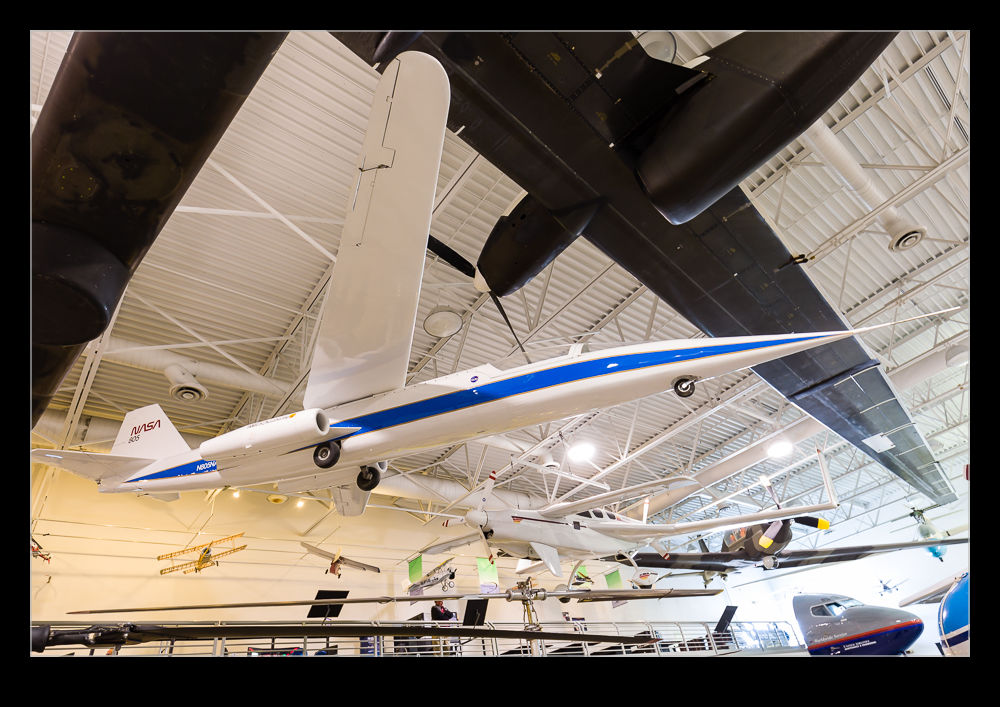 Hiller Aviation Museum has another aircraft I find interesting. This is the AD-1 Oblique Wing research aircraft from NASA. I have crossed paths with this machine before. I have seen it at Hiller before but it was also still at Edwards when I paid a visit to the NASA facility there in 1990. The oblique wing concept is an interesting one. Swing wing aircraft aim to combine he low speed and high speed characteristics required into one plane by having multiple wing sweep angles. The oblique wing approach aims to simplify this by having a single wing that pivots. The sweep angle is the same but eh CG is unaffected and the pivot mechanism much simpler.
Hiller Aviation Museum has another aircraft I find interesting. This is the AD-1 Oblique Wing research aircraft from NASA. I have crossed paths with this machine before. I have seen it at Hiller before but it was also still at Edwards when I paid a visit to the NASA facility there in 1990. The oblique wing concept is an interesting one. Swing wing aircraft aim to combine he low speed and high speed characteristics required into one plane by having multiple wing sweep angles. The oblique wing approach aims to simplify this by having a single wing that pivots. The sweep angle is the same but eh CG is unaffected and the pivot mechanism much simpler.
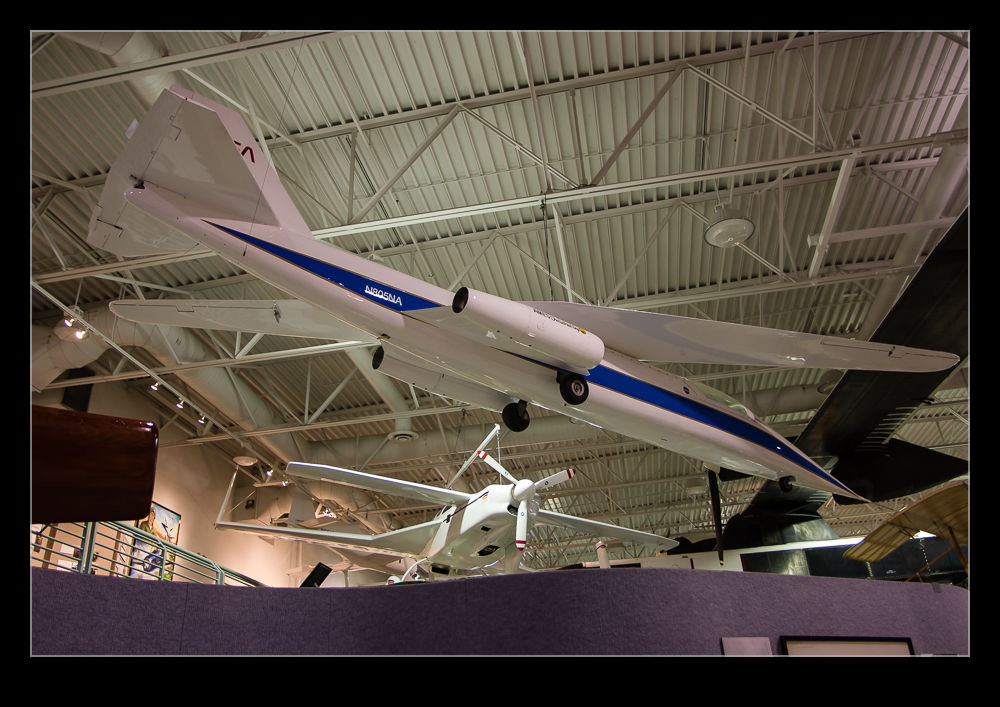 Forward swept wings are fine so, while the oblique wing looks odd, it should be practical. It will have some interesting aeroelastic issues to be dealt with but, it should be possible to engineer. Whether it will then deliver the benefits has never been tested. The AD-1 was a low speed research aircraft only but it flew many times over the years it was in service. Now it hangs from the roof of the museum.
Forward swept wings are fine so, while the oblique wing looks odd, it should be practical. It will have some interesting aeroelastic issues to be dealt with but, it should be possible to engineer. Whether it will then deliver the benefits has never been tested. The AD-1 was a low speed research aircraft only but it flew many times over the years it was in service. Now it hangs from the roof of the museum.
Moffett Field Museum
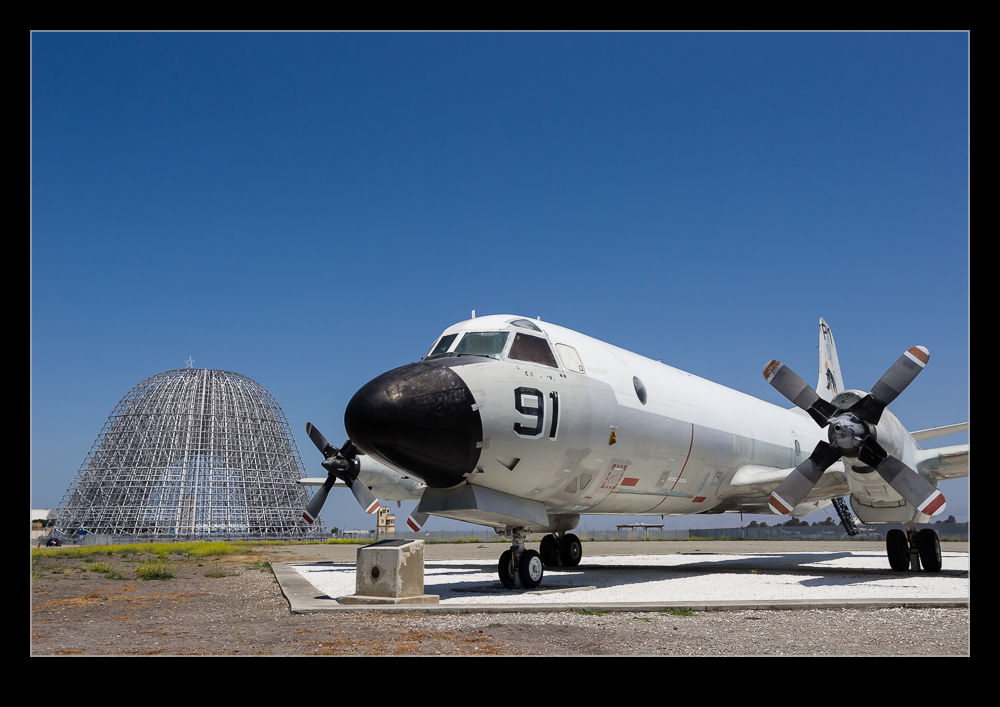 Paul’s visit also included a trip to Moffett Field. Neither of us had visited the museum there so we were both interested in having a look. To be honest, we had assumed it would be a relatively quick visit but the place was very interesting and a docent ended up chatting to us about lots of features in the museum and he was a great guy to talk to. He also took us outside to look at some of their more interesting aircraft.
Paul’s visit also included a trip to Moffett Field. Neither of us had visited the museum there so we were both interested in having a look. To be honest, we had assumed it would be a relatively quick visit but the place was very interesting and a docent ended up chatting to us about lots of features in the museum and he was a great guy to talk to. He also took us outside to look at some of their more interesting aircraft.
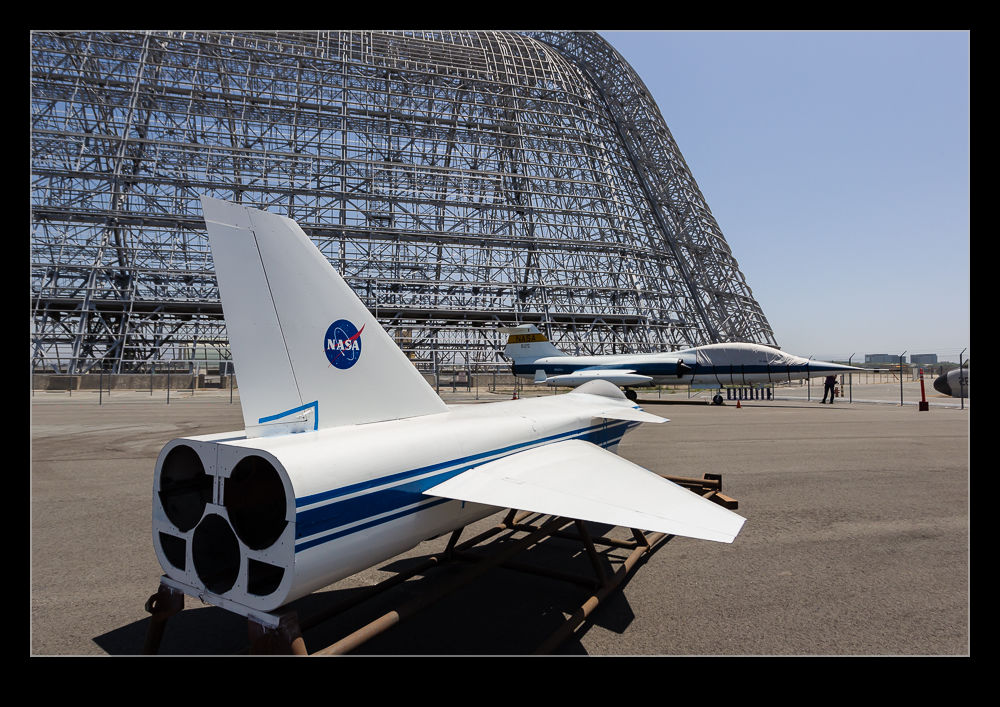 There are a few preserved aircraft at Moffett. Some restoration work continues and their P-2 Neptune is currently across the field being worked on. A P-3 is a short walk away from the museum but they have a fenced off area with a few other exhibits. These include an F-104G Starfighter that NASA used to operate, an AH-1 Cobra from the US Army, a research wind tunnel model (Moffett has an interesting selection of wind tunnels even after the demolition of the biggest one a few years ago) and their centerpiece, a Lockheed U-2. It is currently awaiting reassembly so the wings are on supports alongside the aircraft awaiting reattachment. They have worked hard on restoring it and it looks really cool. The camera installation is inside the museum as well.
There are a few preserved aircraft at Moffett. Some restoration work continues and their P-2 Neptune is currently across the field being worked on. A P-3 is a short walk away from the museum but they have a fenced off area with a few other exhibits. These include an F-104G Starfighter that NASA used to operate, an AH-1 Cobra from the US Army, a research wind tunnel model (Moffett has an interesting selection of wind tunnels even after the demolition of the biggest one a few years ago) and their centerpiece, a Lockheed U-2. It is currently awaiting reassembly so the wings are on supports alongside the aircraft awaiting reattachment. They have worked hard on restoring it and it looks really cool. The camera installation is inside the museum as well.
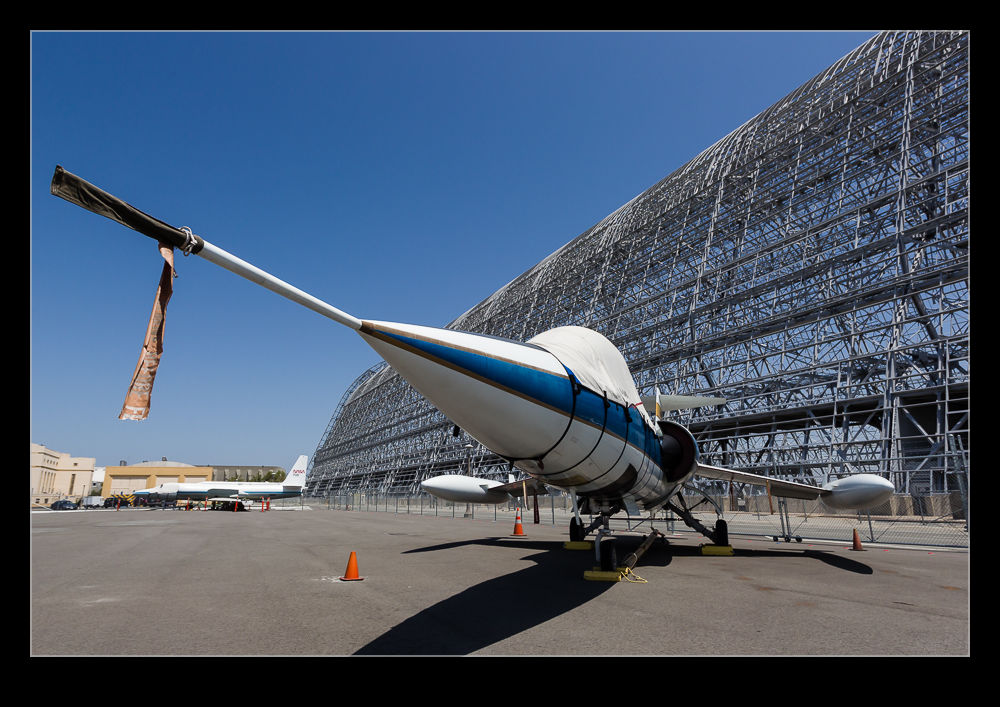 Moffett Field’s history as an airfield is an interesting one and they cover it well. Whether it is the early airship work and the huge hangars that are still on the field or the long presence the US Navy had, the current ANG rescue operations or the NASA research activity, they have it covered. Do pay them a visit and support the work that they are doing. They have a few cool aircraft that are on the other side of the field which are currently out of bounds to the public so I shall have to see if there is a way to get to see them at some point.
Moffett Field’s history as an airfield is an interesting one and they cover it well. Whether it is the early airship work and the huge hangars that are still on the field or the long presence the US Navy had, the current ANG rescue operations or the NASA research activity, they have it covered. Do pay them a visit and support the work that they are doing. They have a few cool aircraft that are on the other side of the field which are currently out of bounds to the public so I shall have to see if there is a way to get to see them at some point.
Shuttle Memories
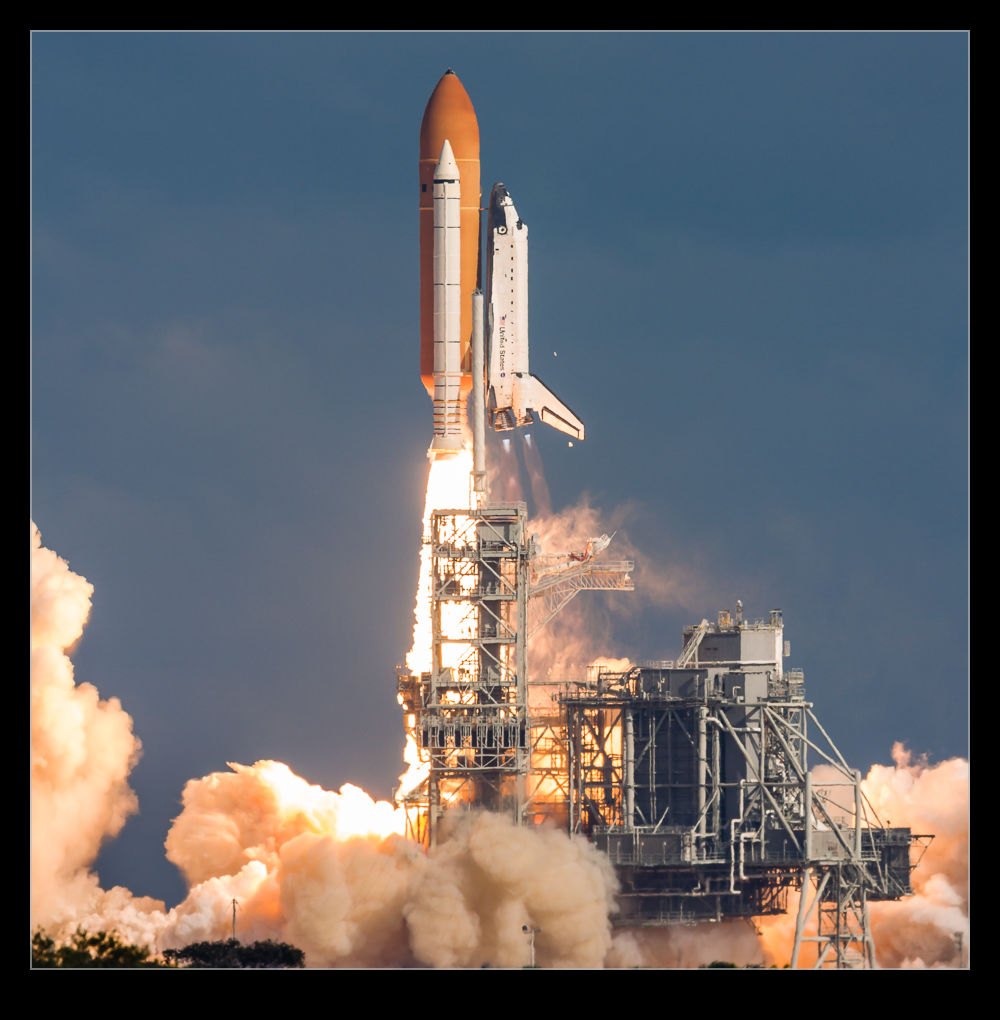 A New Year often gives you a moment to reflect on things from the previous year. One of the things I wished to see this year but didn’t was the delivery of the shuttles to their final homes in museums. It didn’t work out and that is done. However, I did get to see a shuttle launch once during the program and that happened before I started blogging so I decided to have a post that maybe gets counted as an archive outing (or is that lack of recent shots means I have to go back and get old stuff?).
A New Year often gives you a moment to reflect on things from the previous year. One of the things I wished to see this year but didn’t was the delivery of the shuttles to their final homes in museums. It didn’t work out and that is done. However, I did get to see a shuttle launch once during the program and that happened before I started blogging so I decided to have a post that maybe gets counted as an archive outing (or is that lack of recent shots means I have to go back and get old stuff?).
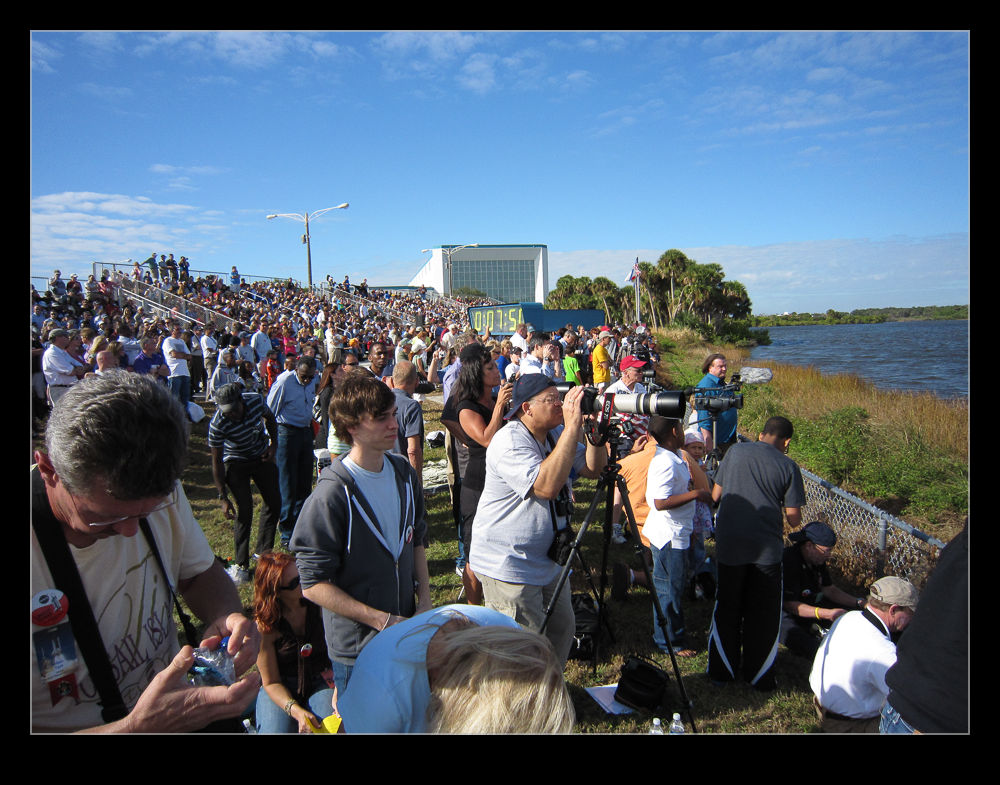 Anyway, here are some shots from the launch of Atlantis on STS-129 in November 2009. This was a trip that could have ended up going sadly wrong but in the end it was a great success. We had planned to make a trip to see a launch for a while and this one was one we had picked out for various reasons. However, we failed in our first effort to get tickets for the causeway which was where I wanted to be to be as close as possible. When we couldn’t get that, we decided instead to get tickets for the visitor center since it would still be a good place to see things.
Anyway, here are some shots from the launch of Atlantis on STS-129 in November 2009. This was a trip that could have ended up going sadly wrong but in the end it was a great success. We had planned to make a trip to see a launch for a while and this one was one we had picked out for various reasons. However, we failed in our first effort to get tickets for the causeway which was where I wanted to be to be as close as possible. When we couldn’t get that, we decided instead to get tickets for the visitor center since it would still be a good place to see things.
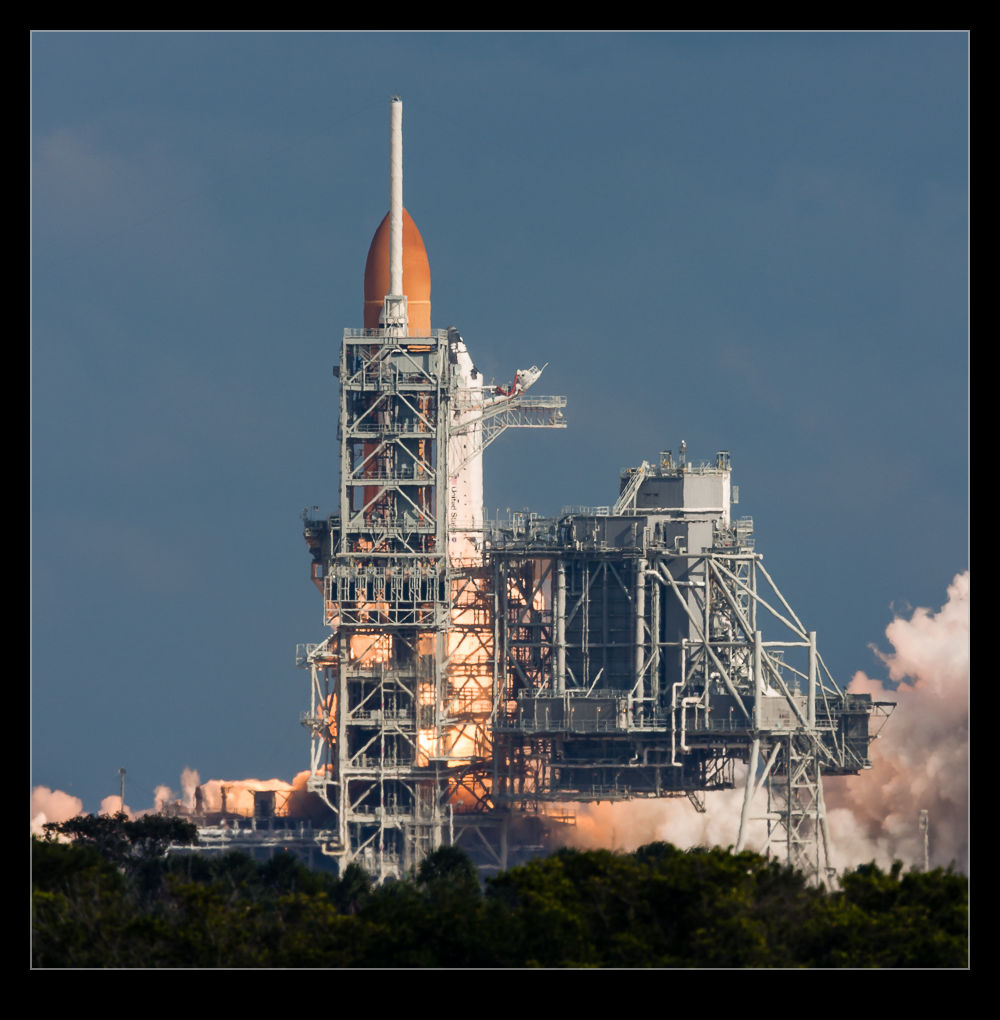 We planned a few days in Florida with the launch on the first full day there. The idea was that we would have some margin if the launch got delayed (as they often did). Unfortunately, NASA were one step ahead of us and moved the launch after we had made out travel arrangements. They moved the launch to the last day we were due to be there. This made it a one shot deal. Once we were down there, we had a few days to look around. While out wandering around Celebration, I got a call from a good friend of mine. He didn’t know where we were but, when I told him, he said he knew a retired astronaut who might be able to help us out.
We planned a few days in Florida with the launch on the first full day there. The idea was that we would have some margin if the launch got delayed (as they often did). Unfortunately, NASA were one step ahead of us and moved the launch after we had made out travel arrangements. They moved the launch to the last day we were due to be there. This made it a one shot deal. Once we were down there, we had a few days to look around. While out wandering around Celebration, I got a call from a good friend of mine. He didn’t know where we were but, when I told him, he said he knew a retired astronaut who might be able to help us out.
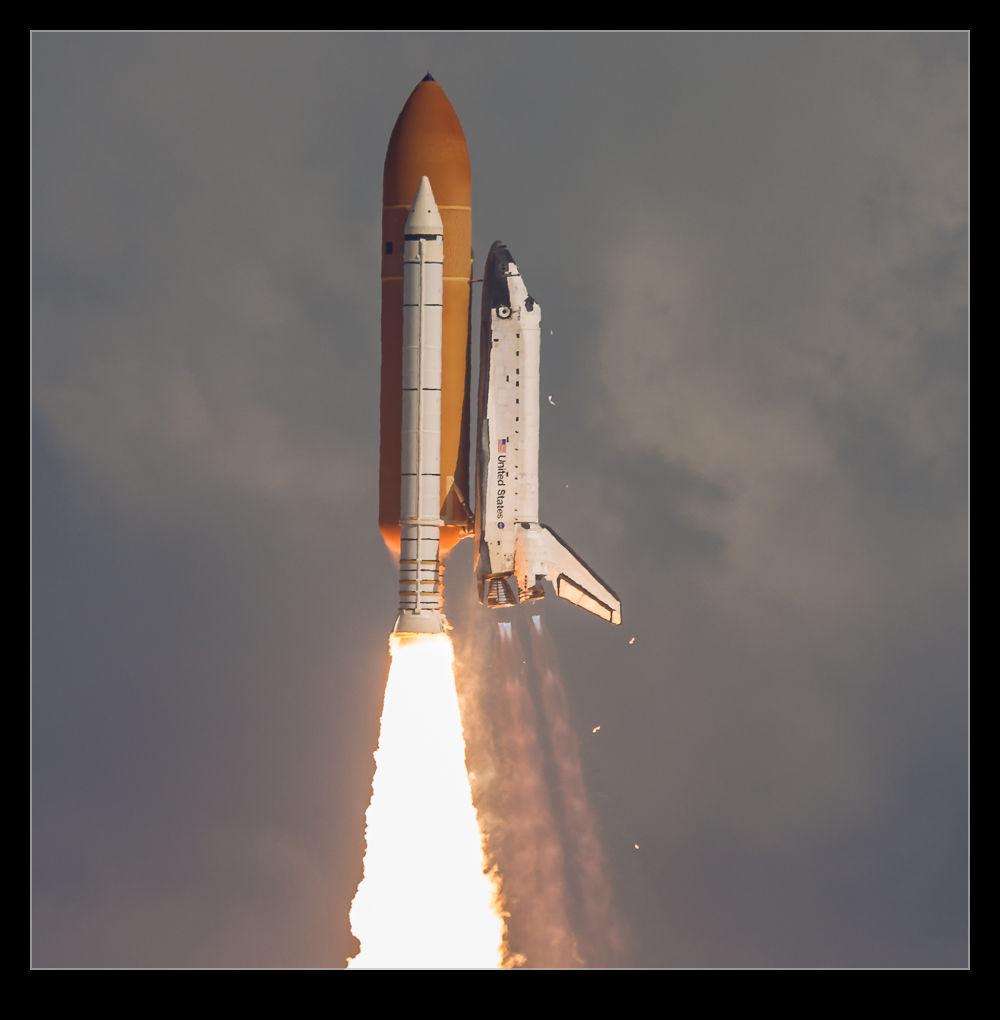 I have to admit I thought this was a long shot. An hour later, he calls back and tells us we are on a VIP bus. We have to go to KSC the next day and they will have our information and sort us out. I was stunned. Needless to say, we went to KSC the next day. Initially, they didn’t know who we were but they did eventually sort it all out and we were now on a better plan than we could have envisioned. We even got premium parking! Come the day of the launch we headed out early – no point in being late for something like this.
I have to admit I thought this was a long shot. An hour later, he calls back and tells us we are on a VIP bus. We have to go to KSC the next day and they will have our information and sort us out. I was stunned. Needless to say, we went to KSC the next day. Initially, they didn’t know who we were but they did eventually sort it all out and we were now on a better plan than we could have envisioned. We even got premium parking! Come the day of the launch we headed out early – no point in being late for something like this.
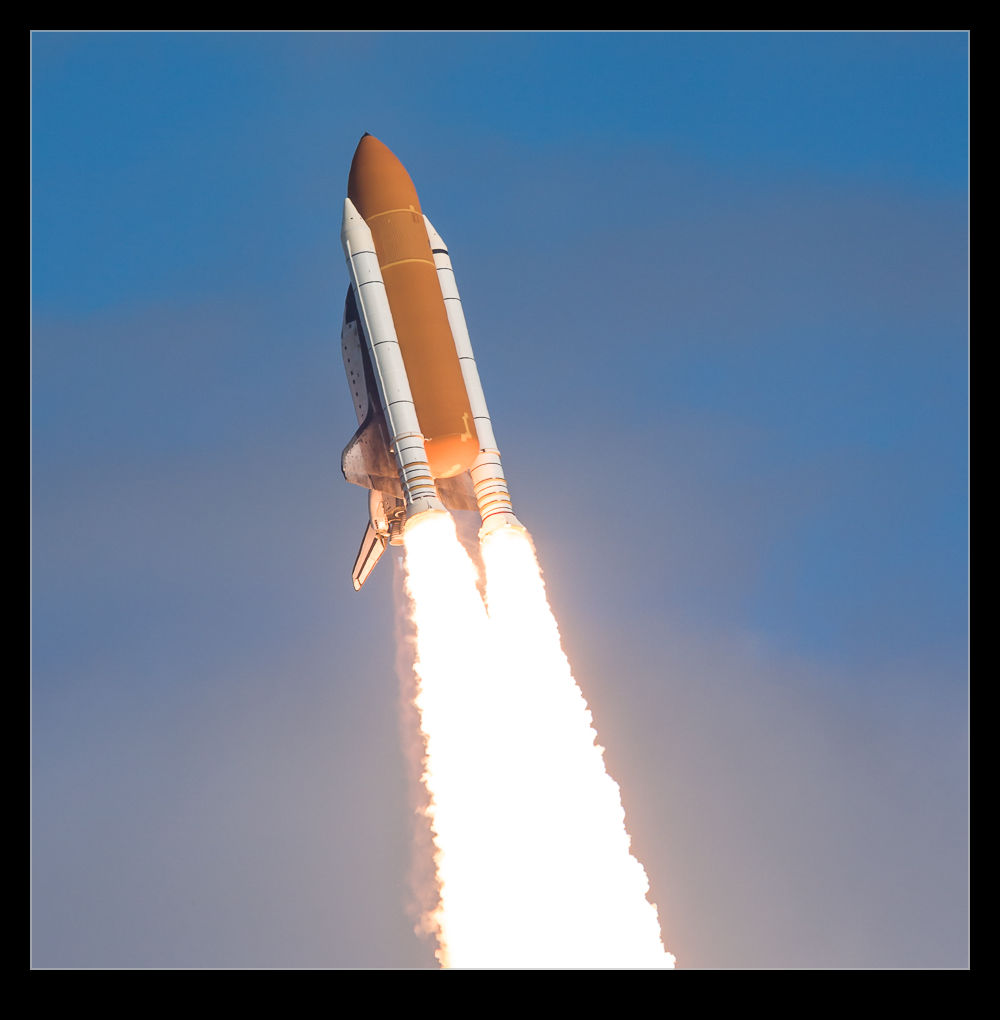 The atmosphere at the visitors center where we had to go first was excellent. There were loads of people there and everyone was excited. It was like being at a fair. When the time came, we loaded up on the buses and went to Banana Creek. This is just past the Vehicle Assembly Building. Moreover, you are looking across water the whole way so, while you are slightly further away than the press area at the VAB, you don’t have much heat haze – a big deal when shooting over three miles in Florida! This area was really busy as well and this group was probably even more excited than the crowd at the visitor center. There were a really nice bunch of people around us and the time zipped by.
The atmosphere at the visitors center where we had to go first was excellent. There were loads of people there and everyone was excited. It was like being at a fair. When the time came, we loaded up on the buses and went to Banana Creek. This is just past the Vehicle Assembly Building. Moreover, you are looking across water the whole way so, while you are slightly further away than the press area at the VAB, you don’t have much heat haze – a big deal when shooting over three miles in Florida! This area was really busy as well and this group was probably even more excited than the crowd at the visitor center. There were a really nice bunch of people around us and the time zipped by.
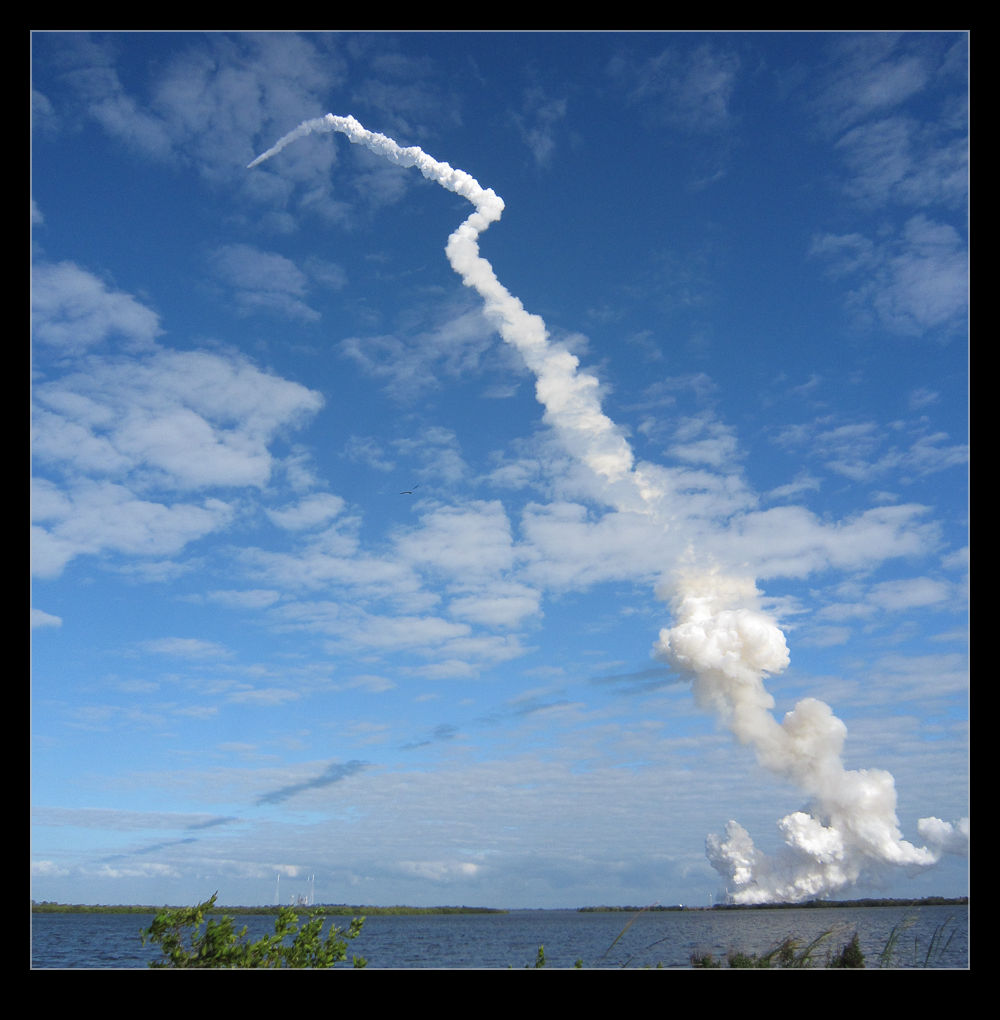 Finally it was time for the launch. It all happened very quickly. Suddenly the countdown was approaching zero and then it happened. A spectacular sight. I shot a ton of shots but I did remember to just look and be impressed by it all. My abiding memory was how orange the flame was. It is so bright that it blows out in all images but when you see it you realize it is very orange. Look at the color of the clouds around and you will get an idea of the true color since they reflect it in a very toned down way.
Finally it was time for the launch. It all happened very quickly. Suddenly the countdown was approaching zero and then it happened. A spectacular sight. I shot a ton of shots but I did remember to just look and be impressed by it all. My abiding memory was how orange the flame was. It is so bright that it blows out in all images but when you see it you realize it is very orange. Look at the color of the clouds around and you will get an idea of the true color since they reflect it in a very toned down way.
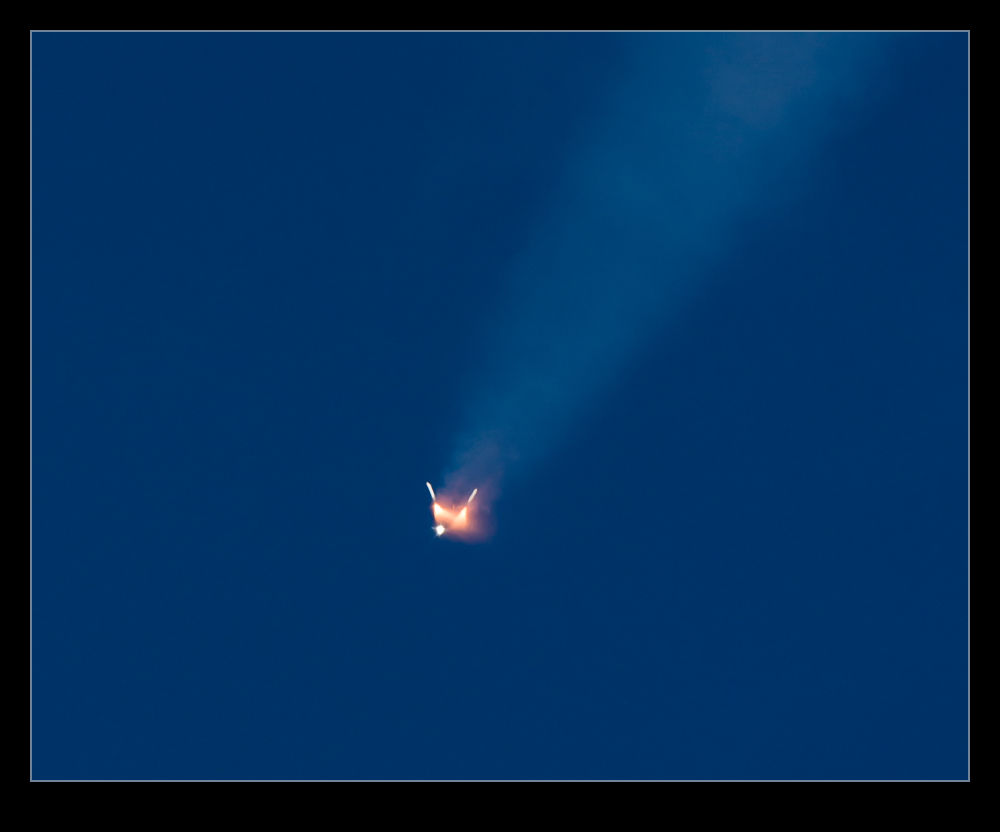 Within a couple of minutes the boosters had separated and it was gone. We were all hurried back onto the buses since the exhaust plume apparently contains some quite unpleasant chemicals. Then it was all over. It was so sudden and no instant replay! Then it was time to hang around since the traffic out was going to be horrendous (it was even much later). A great experience and one I am always glad I did.
Within a couple of minutes the boosters had separated and it was gone. We were all hurried back onto the buses since the exhaust plume apparently contains some quite unpleasant chemicals. Then it was all over. It was so sudden and no instant replay! Then it was time to hang around since the traffic out was going to be horrendous (it was even much later). A great experience and one I am always glad I did.